Careful who you trust, Hamburg, Michigan Public Safety under FIRE!
From investigation to “ARSON” to crazy court battle!
Facts and Evidence have been provided within each section.
(Best viewed on a computer)
(Homeowners surveillance system times are deviated by approximately one hour)
(Full evidence is located here. Snippets of information have been created to condense this report. Please feel free to browse all reports and evidence.)
Questions? behindthefireorg@gmail.com
On November 19, 2019 at approximately 3:39pm the Hamburg Fire Department was dispatched to a residential fire on Winans Lake Road. A retired police officer who was passing through the area by car, reported the incident after noticing smoke coming from the roof. The witness (Identified by Officer Fischahber), along with two other individuals (Unidentified – Never interviewed), walked up the nearly 400-foot driveway to investigate further.
Officer Fischahber was the first officer to arrive on the scene. He approached the nearly 4,000-square-foot home and opened a sliding entrance door, causing smoke to escape. The officer quickly shut the door. The Hamburg Fire Department, along with other local fire departments, arrived soon after. Chief Nick Miller took control of the scene, while Fire Marshal Jordan Zernick and his team began suppressing the fire. According to Fire Marshal Zernick’s later testimony, the fire was extinguished within minutes, and they then focused on ensuring there were no extensions of the fire.
At this time, the homeowner was returning and met with Officer Hogan at the roundabout off Winans Lake Road. Officer Hogan had the road blocked off when the homeowner arrived. From this vantage point, the homeowner could easily see the fire department further down Winans Lake Road, directly in front of his house, as it was a straight view. They spoke briefly, with Officer Hogan asking the homeowner to confirm his address. After confirming, the homeowner was told he could pull up to the side of the road in front of his house.
The homeowner pulled up and waited, then spoke with a member of the Hamburg Public Safety Department. The officer informed him that he could not enter the house and needed to remain off the property until the fire department gave the all-clear. Concerned, the homeowner explained that nobody had been in the house when he left and expressed his worries about ensuring no one was hurt. He also requested more information on the current situation. The officer allowed him to drive up to his house but instructed him to stay in his car.
While at the bottom of the driveway Fire Marshal Jordan Zernick, focused on his duties, informed the homeowner that he was unsure how long the process would take. While Fire Marshal Zernick and his team were handling the situation, the homeowner waited for hours at the bottom of Winans Lake Road, as shown by video surveillance and his own statement. The homeowner, standing mere feet from his driveway, repeatedly asked members of the fire department and police for an estimated timeline but received no definitive answers. Feeling hungry and in need of a drink to calm down, he left his contact information with an officer and mentioned he would go down the street to get something to eat and drink. The homeowner was not contacted by Police or Fire for approximately 4 hours at 9pm. (In an official report dated 06/09/2020 written by Fire Marshal Jordan makes the claim homeowner left the scene and then the Fire Marshal went back to his command post) This would turn out to be untrue as the homeowner can be seen in the road after their discussion until the power is cut on Security cameras for over an hour.

After the fire was suppressed and extensions were checked some time between 4 and 5 PM, the fire department left the scene, but Fire Marshal Zernick remained with the police. According to the NFIRS Report (National Fire Incident Reporting System) the last firefighter crew at the scene left 6:22pm
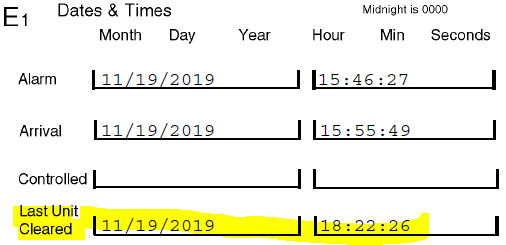
The Fire Marshal transitioned into investigative mode, as indicated in testimony and statements. Fire Marshal Zernick contacted off-duty police officer Spencer Flavin for assistance with the investigation. Officer Flavin arrived sometime between 5 and 6 PM. Under oath, Spencer Flavin stated that he occasionally assists the Fire Marshal with such investigations.
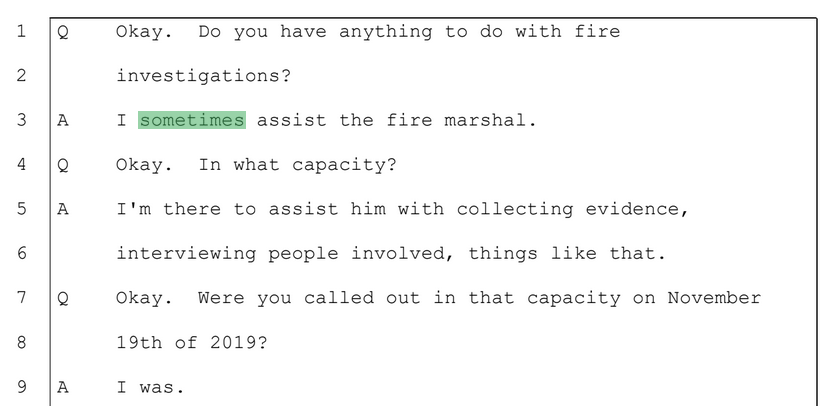
Under Michigan law, fire department and police officials are permitted to enter a house with the owner’s consent, under exigent circumstances, or by obtaining a warrant. They are allowed to collect evidence that is in plain view during their lawful presence, such as during active firefighting efforts. Furthermore, Officials may conduct investigations after the fire to determine its cause within a reasonable time frame. However, once the immediate danger has passed, any further search typically requires a warrant unless it falls under a recognized exception to the Fourth Amendment, such as consent or exigent circumstances.
According to 06/09/2020 testimony, on the night of November 19, 2019, the Fire Marshal found the circumstances of the fire to be suspicious and suggested that a potential crime had occurred. He called police Sergeant Harpe the night of the fire to inform him of this. At approximately 9 PM, Hamburg Public Safety contacted the homeowner, who had been waiting for their call. Upon returning to the scene, the homeowner spoke with Fire Marshal Zernick and Officer Flavin, they did not convey there thoughts of a suspicious fire to the owner. They did say the fire started in the basement, and that smoke occupied the rest of the house and caused damage. The homeowner was shocked upon seeing his house from his driveway. The Fire Marshal informed him that the property would be boarded up and that Belfor, a restoration company, had been called to secure the premises and that he needs to call his insurance company.
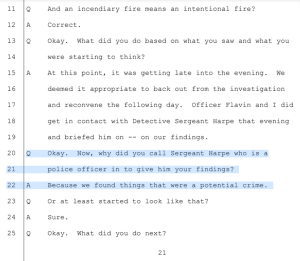
While discussing the fire, the homeowner requested access to the house but was denied. He asked for his desktop computer and gave the specific area it would be in. The Fire Marshal went into the house as directed retrieved the computer and came outside handing it to the homeowner. During testimony, when questioned why he allowed the homeowner to take the computer from a scene of a suspicious fire, the Fire Marshal responded, “I’m a good guy sometimes; you live and you learn.” The homeowner retrieved his computer, which contained 14.2 bitcoins, family photos, and other sensitive data.

The homeowner also informed the Fire Marshal that the property had a security camera system and provided the location for the DVR’s specific retrieval. The homeowner is specific on where it is located citing its location is in the laundry room. (This is important as to the scope of retrieval)
After the Fire Marshal obtained the DVR the homeowner was asked if it needed a password. The homeowner mentioned that he did not have it, the DVR company had the password but homeowner could log in through his phone, but he did not have the password, he states if “you can get the password you can login.” (It would later turn out that Hamburg Public Safety accessed the footage without the password)
In between retrieving the DVR and bringing it outside and requesting password information the Fire Marshal and Officer Flavin conduct a potentially illegal search. Upon entry to retrieve the DVR in the laundry room Fire Marshal Zernick and Officer Flavin took the opportunity to search outside the scope of just the laundry room. Since the fire was put out hours beforehand there is no exigent circumstances to be searching anywhere. This entrance was not part of any origin and cause investigation. The footage reveals Fire Marshal Zernick searching through the homeowner’s desk, medicine cabinet, closets, and even looking for guns in areas of the house far from the fire’s origin. The homeowner did not grant permission/consent for these rooms to be searched, nor was such permission requested or given, as confirmed by the body camera footage.
*After the fire is extinguished and the emergency addressed, the need for further investigation, especially if it involves searching through personal belongings or private areas, generally requires a warrant unless another exception applies. In this case the fire is out and there is no emergency instances where the Fire Marshall and Officer need to be searching through the homeowners’s house. Michigan v. Tyler & Michigan v. Clifford
It is only after these potential illegal actions, Officer Flavin is heard suggesting that they obtain a signed consent form for the search. Fire Marshal Zernick responds by saying he might have a form in his truck. The footage then shows Zernick exiting the home. He eventually goes to his truck presumably to find a consent form. Officer Flavin goes outside and asks the homeowner a few more questions and then approaches the truck and the audio is suspiciously and intentionally muted, and the camera field of view is blocked or is turned off. When the camera is turned back on, Officer Flavin is seen speaking with the homeowner. Fire Marshal Zernick then informs the homeowner that the house would be boarded up for the night and that the investigation would continue the following day. Sergeant Harpe of the Hamburg Police Department documented the contact by Fire Marshal Zernick in regards to an intentionally set fire within his report.
In the police report created by Sergeant Harpe, dated December 1, 2019, it is confirmed that contact was made on the 19th to assist in determining the cause and origin of the fire. The report also documents that the fire was considered suspicious, further noting the suspicion of a crime. Additionally, the report states that the Fire Marshal had obtained a signed consent form on the night of the fire, which was later found to be false. As we will delve into later, it’s important to note that since a crime was suspected at this time, the Fire Marshal should have obtained a warrant to continue his investigation and search.
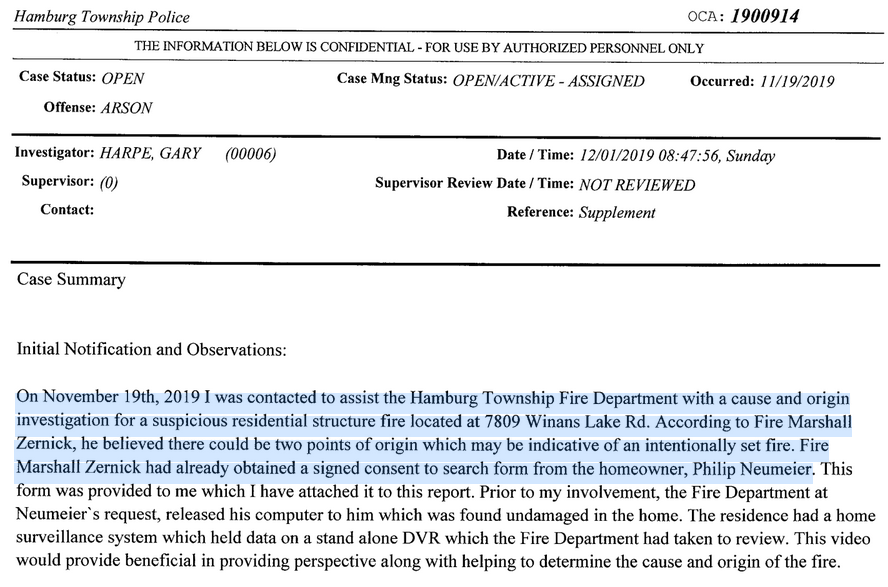
The homeowner left the scene the night of the fire to stay at his office in the neighboring city of Brighton. Before leaving, there was no request by the Fire Marshal or any officer for permission to enter the house beyond retrieving the computer and DVR. Nor was the homeowner asked about signing a consent form. The footage does not capture any instance of the homeowner granting permission for any extended search or being asked to sign a consent form. The retrieval of the DVR and his computer was the full extent of any access granted.
Despite this, subsequent events raised significant concerns, as the proper procedures for obtaining consent appeared to have been intentionally overlooked. Something extremely suspicious occurred: the Fire Marshal somehow produced a Consent to Search Form that seemed to be filled out and signed by himself, the homeowner, and a witness officer, dated the night of the fire. This form was then used, along with other government personnel, to gain access to the homeowner’s property for weeks.
The only problem is that the homeowner never signed a consent form on the night of the fire, November 19, 2019 (or the following day, for that matter). There is no mention in any of Fire Marshal Zernick’s reports or logs of the homeowner signing this very important document.
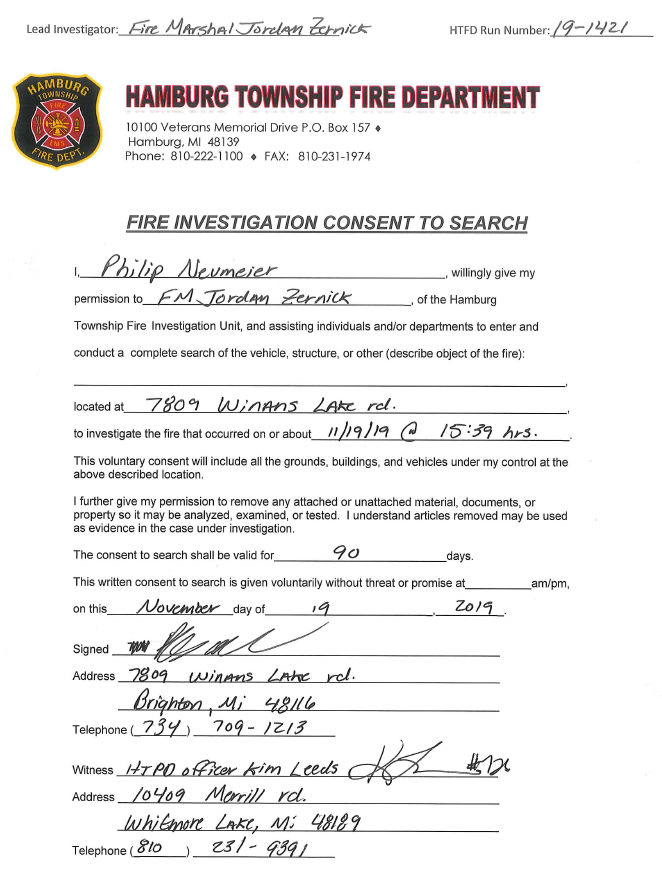
However, it wouldn’t be until much later after the damage was already done that it was discovered that the Fire Marshal did not have a valid signed consent the night of the fire. This also absent of a search warrant at the time. The homeowner stated that he never signed a consent to search form either on the day of the fire or the day after. He also was never asked for permission verbally to investigate the the fire within his home by Hamburg Public Safety. Nor is it documented in any report by the fire Marshall of such an encounter. How did a signature representing that of the owners end up on a form? Your guess is as good as anyone, but even the witness signature by officer Kim leeds is of question? Officer Kim Leeds signature is on this form. This is odd because Officer Kim leeds wasn’t even working the night of the fire, and under oath during a motion hearing she could not remember ever seeing this consent form or even signing it. Yet there her signature is on there. We can only speculate as to how two people one being an officer and the other being the homeowner both recall not signing this document.
Officer Leeds Testimony - (Waiting on transcripts)
Things only get stranger. On 06/09/2020 in court, the Fire Marshal Zernick testified to the homeowner signing a consent form but now he claimed it was the following day November 20th and that homeowner signed it at the police station. The homeowner knowing this to be 100% false figured if he was supposedly in the police station signing a document they would have it on video, or the very least the homeowner would be seen driving into the parking lot or walking into the lobby of the station. The homeowner’s attorney requested that information and to no surprise a response of “No recording exists” from Sergeant Harpe.
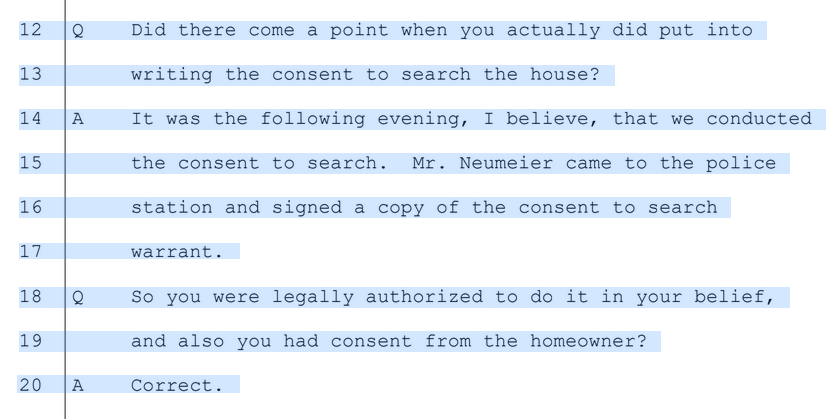

The testimony on June 9, 2020, and again on July 24, 2024, highlighted significant inconsistencies. The homeowner requested a hearing to quash evidence, where the Fire Marshal’s testimony once again conflicted with his reports and previous statements. Initially, the Fire Marshal suggested the consent form might have been signed the day after the fire but eventually conceded that it was not signed by the homeowner on the 19th, as dated.
During the hearing on July 24, 2024, Officer Kim Leeds testified that she did not recall witnessing the signing of any consent form or signing it herself. When asked where the homeowner signed the form, the Fire Marshal stated it was at the Hamburg Police Department and the reason is was so it could be video recorded. This claim was shocking because an email from Sergeant Harpe on June 20, 2022, indicated there was no footage of the event. FOIA requests for video further supported the claim that none existed.
It turned out that the Hamburg Police had no video footage of the event, nor any footage of the homeowner in the lobby, parking lot, or interview room.
Testimony ultimately proved the homeowner correct when the Fire Marshal admitted there was no consent form signed by the homeowner on the day of the fire, and Officer Kim Leeds did not work until late at night the following day.
Despite this, a motion to quash the consent form before Judge McGivney of the Livingston County Circuit Court was denied, even with testimony acknowledging the inaccuracies and lack of witnesses to the form on the day in question.
Judge's Decision - (Waiting on Transcripts)
The homeowner found Hamburg’s actions manipulative and unacceptable, as they knew they didn’t have a signed consent form. This was not the first instance of questionable behavior by Fire Marshal Zernick. Fire Marshal Zernick would then say November 20th he had a sign consent form but this also would not make sense.
On the night of the fire, before leaving, Fire Marshal Zernick told the homeowner he would contact him the following day to discuss the incident. The homeowner responded with requesting to be called after 2pm the following day due to the homeowner suffering from Delayed Onset Insomnia. (Also Documented in Officer Flavins 6/5/2020 report) The following morning (20th), the homeowner received a voicemail from Hamburg Public Safety stating that the Fire Marshal could not meet with him that day. All evidence points to the homeowner being correct that he did or sign any consent form the day of or post.

An audio voicemail was left for the homeowner on November 20, 2019, the day after the fire, referring to a conversation scheduled for 2 PM. This voicemail establishes that, even on November 20th, the Fire Marshal was unavailable to meet. Along with emails and testimony, this supports the fact that no consent form could have been signed the day after the fire either. (Audio File was converted from AMR. to MP3)
It wasn’t until 2 days after the fire November 21st at 8:58pm PM that the Fire Marshal Zernick even requested to meet with homeowner. This would be the first time the homeowner would go to the police station. However, this request was not to sign a consent form but rather a request drop off his notes. The homeowner did drop them off but no discussion on the notes or conversation about the fire happened. As documented, a statement was not needed and it was just a request to drop off. It is important to note that this encounter is not documented in any report with respect to any consent form.
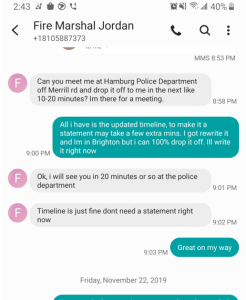

On the November 22nd the homeowner drove to his house to pick up postal packages and noticed the caution tape had been severed. Concerned, he immediately went to check things out and contacted the Fire Marshal. Fire Marshal Zernick informed him that the Hamburg Fire Department had broken the tape. Upon driving up his driveway, the homeowner found business cards from various adjusters scattered around the property. Alarmed by the possibility of unauthorized access, he contacted the Fire Marshal again to report the situation. The Fire Marshal responded that it was fine and advised the homeowner to stay away from the property. Zernick assured the homeowner that he would reach out to discuss his notes and establish a timeline when he was ready.

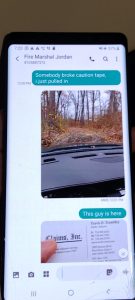
Unbeknownst to the homeowner, Fire Marshal Zernick was investigating an alleged suspicious fire, which had potential criminal implications. Entering the home on November 20th and 21st without valid consent or the authority of the homeowner. During this investigation, Zernick reported discovering two points of origin for the fire within a single room. He also reviewed footage from the homeowner’s video surveillance system. Without obtaining the necessary password, Zernick allegedly opened the DVR, removed the hard drive, and accessed the video footage without the homeowner’s permission or a warrant.
In a police report written on 6/05/2020 by Officer Flavin, it is stated that the homeowner gave permission to collect the DVR and review the footage. However, the report conveniently omits that this permission was limited to using a password, as captured on body camera footage the night of the fire. The homeowner did not give permission to open the DVR or access it by any other means.

Fire Marshal Zernick did not contact the homeowner about going over his notes or timeline until November 27th, at which point the manipulation seemed to intensify. The homeowner was celebrating Thanksgiving a day early at his childhood friend’s house, with their family and his son, when the Fire Marshal called. Over the phone, Zernick asked the homeowner if he could meet to go over the timeline, assuring him it would only take 15-20 minutes. The homeowner explained that he was celebrating Thanksgiving a day early with his son and friends then asked if it would be acceptable to go over the notes over the weekend. However, the Fire Marshal insisted on meeting that day. The homeowner reluctantly agreed.
Upon arriving at the provided address, the homeowner realized it was the Hamburg Police Station. He walked in and was met by Sergeant Harpe and Fire Marshal Zernick. He was immediately taken into Interrogation Room 114-a, where he was seated with his back against the wall, Sergeant Harpe sat roughly 2 feet to his left, and Fire Marshal Zernick roughly 3 feet in front of him in a tiny room. The homeowner, believing he was there to go over the notes, quickly realized that was not the case. Sergeant Harpe instructed the homeowner to rely on his memory rather than referring to his notes, which was suspicious given the supposed purpose of the meeting. This request raised concerns about the true intent of the encounter, as it appeared to be an attempt to influence or distort the homeowner’s account of events, rather than a genuine effort to clarify and document the facts accurately.
As 25 minutes approach into the meeting the homeowner mentions the time as he is keeping track because his son is being watch by his friends mom. Originally being told it would only take 10-20 mins. Notably, the Fire Marshal, who had called the homeowner, remained mostly silent and did not ask any questions of the homeowner. Within this process the homeowner tells the Sergeant that he is staying at his office and that his son has a room there for when the homeowner is working.
It became clear that the meeting was a pretext to accuse the homeowner of arson, with the intention of arresting him and soliciting a confession.
After roughly 30 minutes of questioning, Sergeant Harpe finally informed the homeowner of the purpose of the meeting. Sergeant Harpe accused the homeowner of arson, alleging that he had wrapped a lamp with a cloth soaked in car oil and placed it under the staircase. Shocked, the homeowner vehemently denied the accusation. Sergeant Harpe pressed further, claiming they had video evidence reviewed by experts implicating the homeowner in the fire. The homeowner repeatedly denied any involvement and challenged Sergeant Harpe to prove the accusation.
The exchange between the homeowner and Sergeant Harpe continued for another ten minutes. Throughout this time, the homeowner expressed a desire to leave and, at one point, asked if he needed a lawyer. Sergeant Harpe responded, “If I arrest you, you will need one,” but would not clarify whether the homeowner was under arrest. When Sergeant Harpe and Fire Marshal Zernick left the interrogation room, the homeowner was ordered to wait in the chair. He immediately called his driver, who was waiting in the parking lot, to inform him of the situation.
After the homeowner made contact with his driver, Sergeant Harpe and Fire Marshal Zernick returned to ask more questions. The driver then entered the station to find out what was happening. Frustrated and raising his voice, the homeowner demanded to know if he was being arrested or if he was free to go. He was eventually allowed to leave.
It’s important to know the difference between an interview and an interrogation are both methods used by law enforcement to gather information but differ in purpose, tone, and legal context. An interview is typically non-accusatory, relaxed, and aimed at gathering information from witnesses or individuals not suspected of wrongdoing, without the need for Miranda rights since the person is free to leave. In contrast, an interrogation is accusatory, often intense, and directed at suspects to obtain confessions or admissions about a crime, requiring Miranda rights if the person is in custody to protect their right against self-incrimination. In this case no Miranda was presented. The homeowner maintain his innocence through out the interrogation. It would be later stated by Sergeant Harpe that this was just an interview. What do you think?
Closer analysis of this footage revealed that after the homeowner left, there was intent to arrest him. Sergeant Harpe said he would just “send a warrant” to the Fire Marshal. Mention being made about not having the necessary paperwork filed for the arrest in the moment. This interrogation was a clear attempt at soliciting a false confession. This incident marked the beginning of manipulative and questionable practices. Following the encounter, the homeowner contacted his family attorney to inform him of the events.
Under oath, Fire Marshal Zernick admitted that the homeowner needed to leave to return to his son. However, when asked why the interview ended sooner than anticipated, his response was vague and understated, failing to provide what actually happened for the early conclusion to occur.

5 days after the interrogation, the Fire Marshal’s actions continued, displaying apparent ill will toward the homeowner. Fire Marshal Zernick contacted Richard Boisvert, the Fire Marshal of Brighton, where the homeowner’s office was located and where he was staying. The two conspired to interfere with the homeowner’s living situation. Fire Marshal Zernick informed Fire Marshal Boisvert that the homeowner was staying at his office. The plan involved contacting Brighton City housing inspection to have the homeowner’s situation inspected, with the intent to potentially remove him or impose penalties for illegal occupancy. They city cites prosecution for this penalty. It would not be until 2024 that the homeowner confirmed the Fire Marshal’s retaliation, this by a FOIA request.
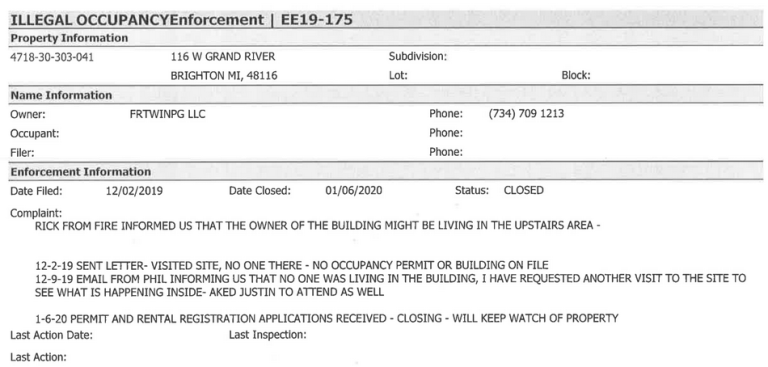

The 2024 FOIA request confirmed the suspicions of the homeowner and was also confirmed in part by Fire Marshal Boisvert (Brighton, Michigan Post) during a telephone call, that the office where the homeowner was staying had ultimatly been approved by the building department for residential living. Therefore, the homeowner was within his rights to reside there, rendering the plan to penalize him baseless. The unnecessary and spiteful actions take by Hamburg Public Safety are truly appalling. During operation 232 the homeowner needed proof of this, he new it was not a coincidence. He dug deeper and found that person named Rick filed the complaint against the homeowner. Rick turned out to be Rick Boisvert, Brighton Michigan’s Fire Marshal. The following is a phone call from July 23rd 2024 between Boisvert and homeowner and what transpired opened even more doors into the corrupt nature of things.
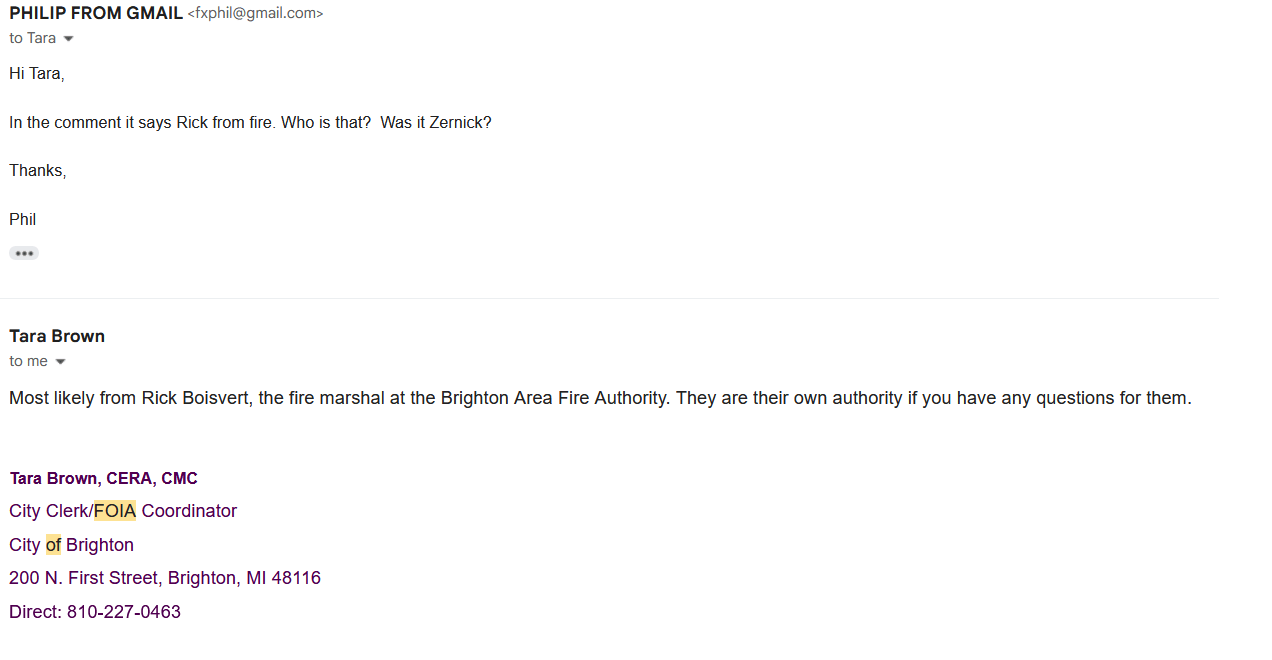

Following this phone call, the homeowner’s attorney received an email from the Livingston County Prosecutor stating that the homeowner could be charged with impersonating an officer and providing a false identification number. At no point during the phone call did the homeowner claim to be any type of government agent; in fact, he explicitly stated that he was not part of the government. The homeowner was able to prove his credentials and demonstrate that he was not impersonating an officer and has been a member of the NAFI since Aug 11, 2020.
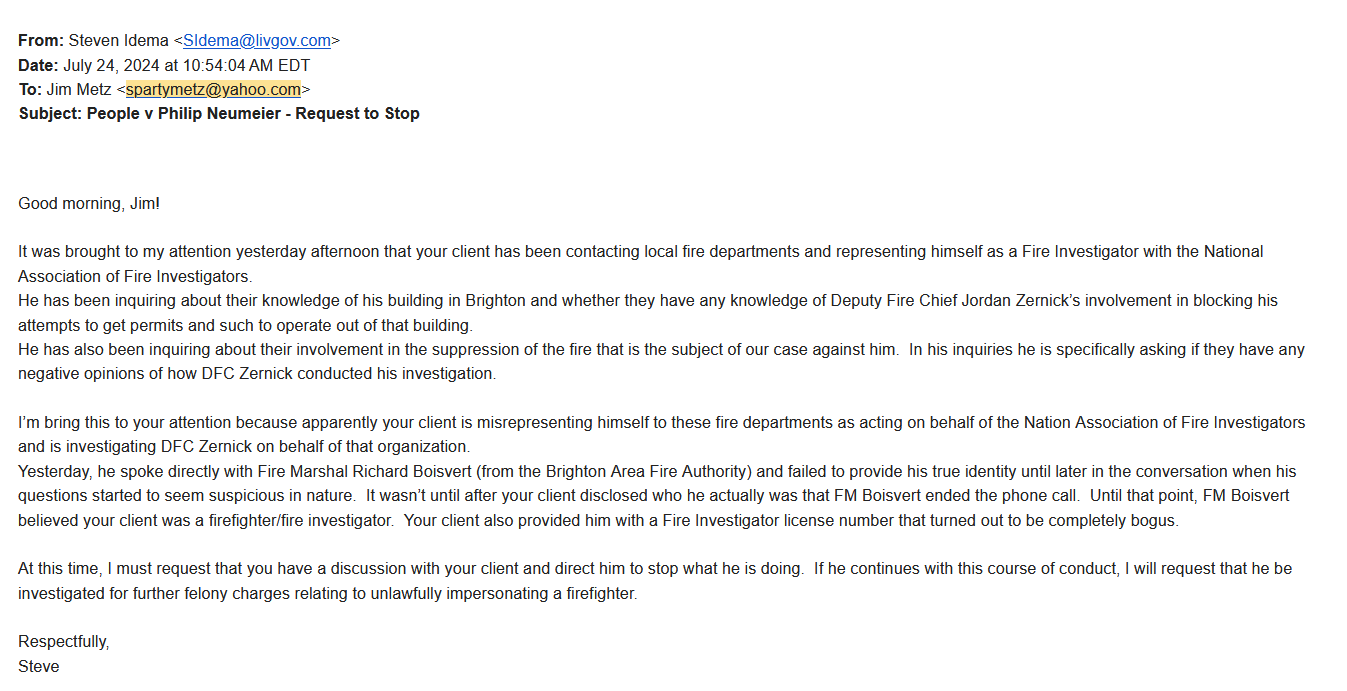
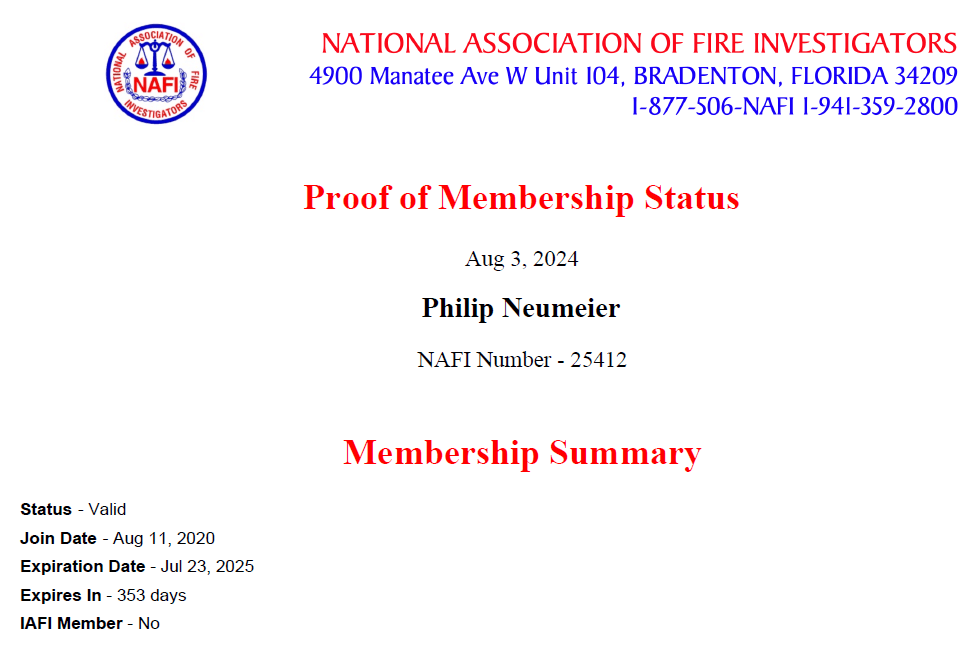
Additionally, Fire Marshal Boisvert was neither a witness against the homeowner nor mentioned in any document, report, or testimony. This would add to the nature of Hamburg’s questionable investigation. However, during the phone call, he admitted to being at the homeowner’s house on the day of the fire and assisting Fire Marshal Zernick. He confessed to helping move debris and being part of the crew that discovered an incendiary device. This statement conflicts with the testimony given by Fire Marshal Zernick, who claimed that he and the insurance investigator (Jeremy Berard) were the ones who found the alleged lamp and oil-soaked cloth device. According to the above phone call, it was actually the two fire marshals who discovered an alleged incendiary device, before waiting for the insurance investigator to arrive.
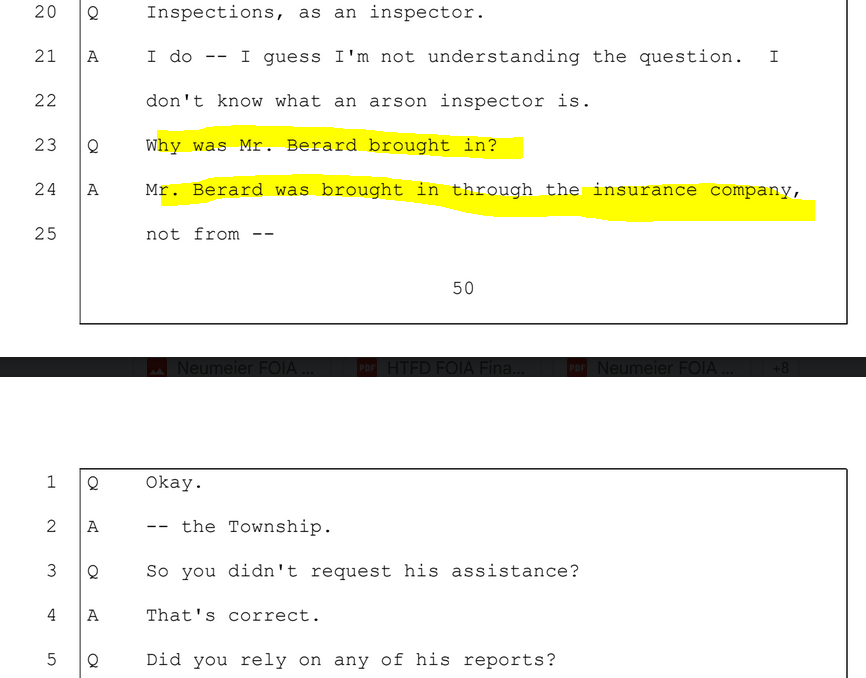
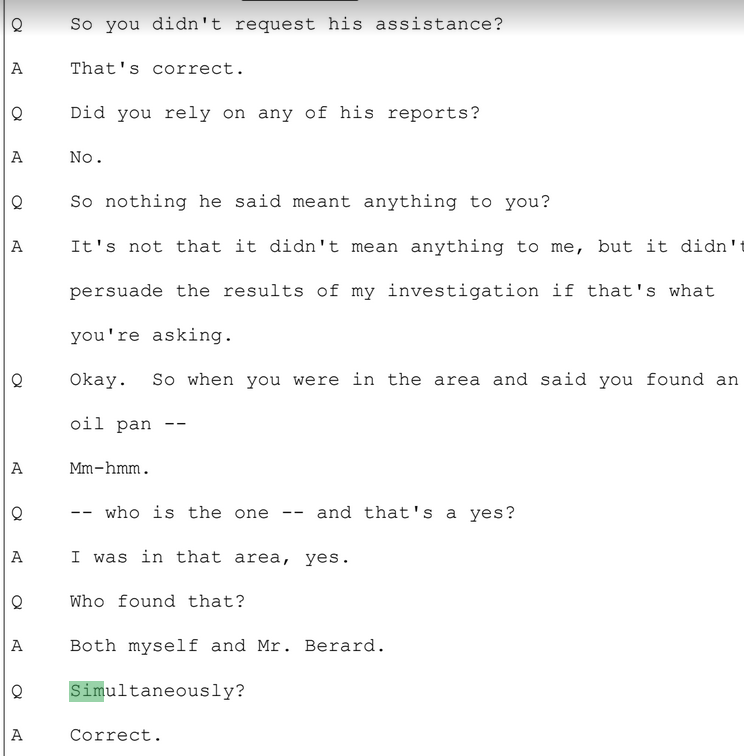
Even in the Fire Marshal’s report, there is zero mention of Fire Marshal Boisvert being present, this would also go for all reports by police or other. The report states that Berard, (insurance investigator) and Fire Marshal Zernick found the incendiary device together. This creates a discrepancy, as Fire Marshal Boisvert indicated during the phone call that he and Fire Marshal Zernick found the an origin point and then waited for the insurance investigator to arrive.

After the interrogation on November 27th, 2019, the situation only became stranger. The homeowner contacted his attorney to look into things with the Hamburg Police and Fire Department. Sergeant Harpe informed the attorney that the homeowner would be charged at some point.
Two days after the interrogation and before handing over all communications to his lawyer, the homeowner sent a message to the Fire Marshal, reiterating that he did not want anyone entering the house and that he intended to hire his own investigative team. Despite this clear request, the Fire Marshal denied allowing the homeowner from hiring his own investigators and letting them on the property. The Fire Marshal though continued to enter the homeowner’s property. Multiple witnesses and neighbors reported seeing the Fire Marshal’s truck at the location. Additionally, detailed reports documented these unauthorized entries into the homeowner’s property.

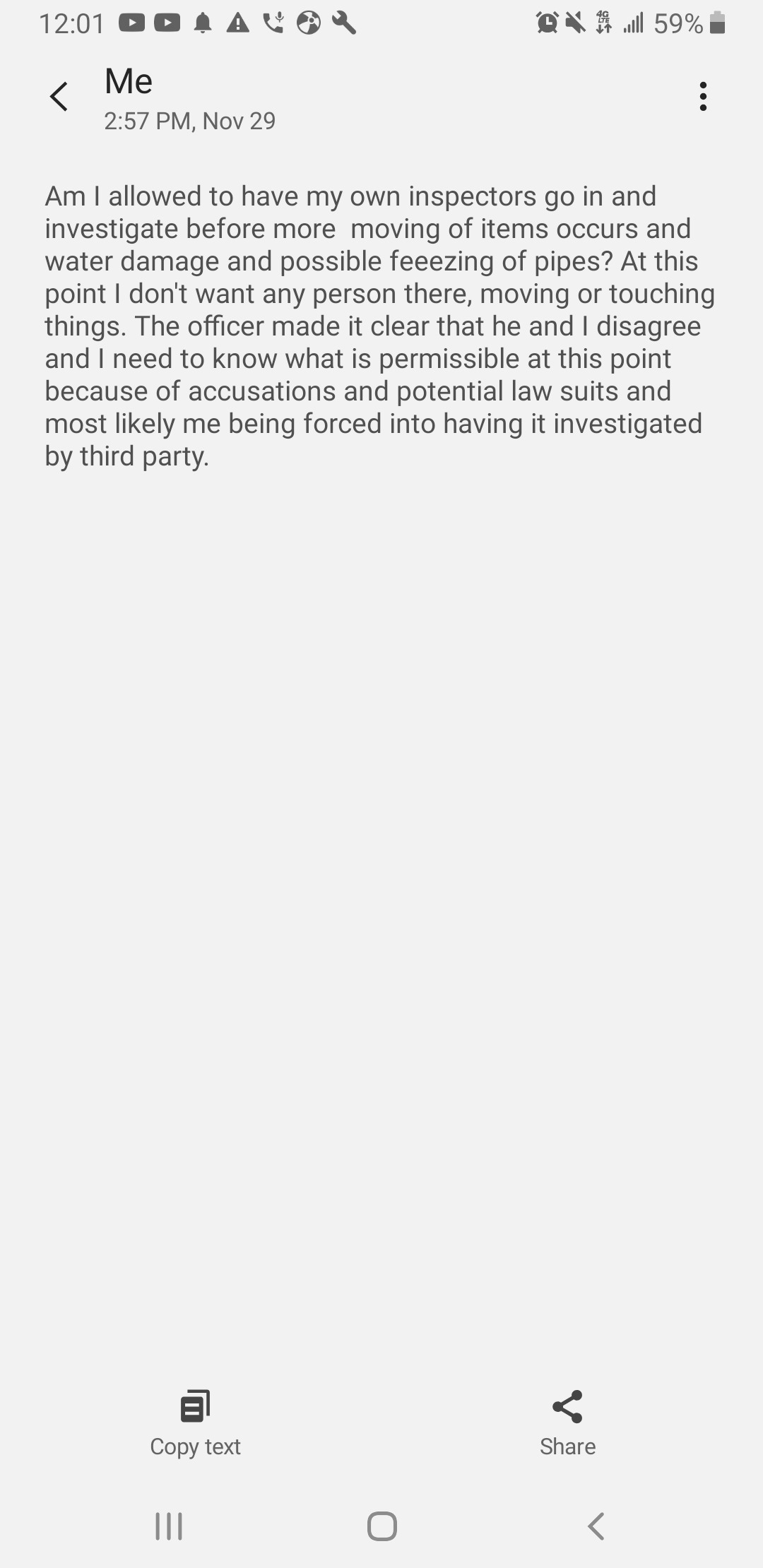
According to a report created by Officer Flavin in June of 2020, an arson K9 dog, trained to detect accelerants, was brought into the house the day after the fire on November 20, 2019. This was because of a discoloration of the floor, which later would turn out to be part of the floors epoxy layer. The report indicates that the K9 unit yielded no confirmed hits, the dog did not alert to the presence of any accelerants. This mention of the K9 unit is the only one on record, with no further report from the K9 dog or its handler being documented. Additionally, this detail was not included in any other reports related to the investigation. There was also no warrant or consent at this time to search. This does prove though that because of a floor discoloration the need for a k9 was needed to specifically search for acclerants. This typically would require a warrant or consent for it not be considered an illegal search.

It was not until three weeks later, on December 11, 2019, that the Hamburg Police Department finally decided to obtain a search warrant. The process of obtaining this warrant raised significant concerns and highlighted the lengths Hamburg PD would go. Sergeant Harpe filled out a sworn affidavit filled with errors and manipulations. In his request, he mistakenly documented the fire as occurring eight days before it actually did, attributing this to a typographical error—a mistake that can happen. However, he also misrepresented his abilities and claimed that he was part of the Hamburg Fire Investigation Team with training and experience in determining the cause and origin of fires. This statement was not equitable to his true experience; FOIA requests and his testimony under oath revealed that Officer Harpe was not certified by the National Fire Protection Association, and was an expert by no means.
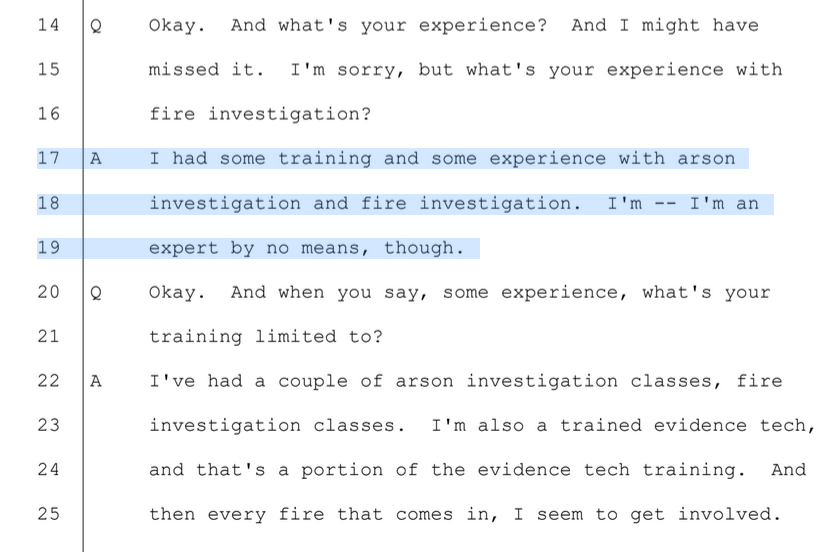
July Testimony NOT NFPA CERTIFIED - Waiting Transcripts
Additionally, the affidavit for a search warrant inaccurately asserted that Fire Marshal Jordan Zernick had obtained written consent to investigate the cause and origin of the fire, which allegedly allowed them to locate and review footage from the DVR’s hard drive. This was concerning, as there was no written consent at the time the footage was reviewed. Among the multiple false statements in the affidavit, one particularly notable claim was that the alleged incendiary device—a lamp wrapped in fabric soaked in oil—was something the homeowner had informed the Fire Marshal of. This claim was not true; the homeowner consistently maintained his innocence, a stance supported by testimony from state witnesses during the preliminary examination hearing. The homeowner never admitted to wrapping fabric around a lamp and placing it in oil. However this was sworn to by Officer Harpe and approved by a magistrate of Livingston county court system.


Despite these discrepancies, and testimony the homeowner’s attorney’s attempt to quash the warrant was denied once again by Livingston County Circuit Judge McGivney. While the motion was heard in court the judge would not allow discussion on some of the key issues of the warrant.
Waiting on Transcript - Judges Determination
It wasn’t until January 9th, 2020, nearly two months after the fire, that the homeowner was finally able to regain access to his house from the Police Department. As part of the conditions, the homeowner and his attorney met Sergeant Harpe at the property. Unbeknownst to the homeowner and his attorney, Sergeant Harpe had placed/or had a hidden recording device inside the home, as documented in his own report. The device was used to secretly record audio during their encounter. The use of a concealed recording device within the homeowner’s house to record communication between the homeowner’s attorney and the homeowner, without a warrant, raises serious legal and ethical concerns.
Officer Harpe at the end of this released the house back to the homeowner.

For transparency purposes and proof of recording it has been posted in its entirety.
This was not the only time Sergeant Harpe manipulated encounters with the homeowner. During the interrogation on November 27th, 2019, the homeowner was honest when asked about his financial background. Sergeant Harpe, in preparation for the interrogation, conducted a basic lien search and testified that the liens amounted to an excess of $200,000. The homeowner was forthcoming about his financial records and acknowledged the liens. It’s important to note that liens on property are not illegal nor do they imply any wrongdoing. The homeowner was working to resolve an IRS issue for nearly 2 years before the fire. The homeowner runs a property management company as one of his hobbies, and managing liens and debt is a routine part of his business. He was in dispute with the IRS over tax benefits. He even informed Sergeant Harpe about the liens, not knowing that Harpe had already conducted a basic search. The issue lies in the fact that Harpe did not verify the exact amounts of the liens or confirm with the IRS the actual situation but it’s what he did next that is perplexing.
Sergeant Harpe chose to misrepresent these financial details, presenting them in a misleading and potentially damaging manner. He further fabricated a claim that the homeowner had discussed being investigated for tax evasion with him and also with his his insurance company. At no point during the interrogation did the homeowner mention or even use the words “tax evasion.” Seargent Harpe would go on to say he doesn’t have any experience with “that stuff”

Upon learning about these false accusations, the homeowner was confused as to why Sergeant Harpe would lie about such a serious crime. To clarify the situation, the homeowner contacted the IRS to verify his tax records. The IRS confirmed that there was never any issue of tax evasion. The phone call was recorded and edited to exclude personal information ensuring the homeowner’s privacy was protected along with hold times and transfers.
Quick Time Reference
7:13 Tax Evasion Question
The audio was recorded live on June 24th 2022. This audio was converted from AAC format to MP3 for online playback. The IRS Agent 1004149775 was aware the call was being recorded. It has been edited to remove private information, such as social security numbers, addresses, and phone numbers. The recording contains brief moments of silence, which are not edits but pauses where the agent was not speaking. The first few minutes of the recording have been expedited along with the last few seconds where the date is verified by the agent. The original complete audio has been compressed by approximately 75 %
The false allegation of tax evasion was repeatedly used throughout the proceedings. It was most recently cited by the prosecuting attorney in a July 12, 2024 briefing, as an argument against a motion filed by the homeowner’s defense team. To this day the homeowner has never been investigated for tax evasion and holds the same tax classification since before the fire in 2019. His bank accounts have never been frozen and no money has ever been garnished nor has there ever been an agent tied to his account. Nobody bothered to verify the sergeants false accusation.
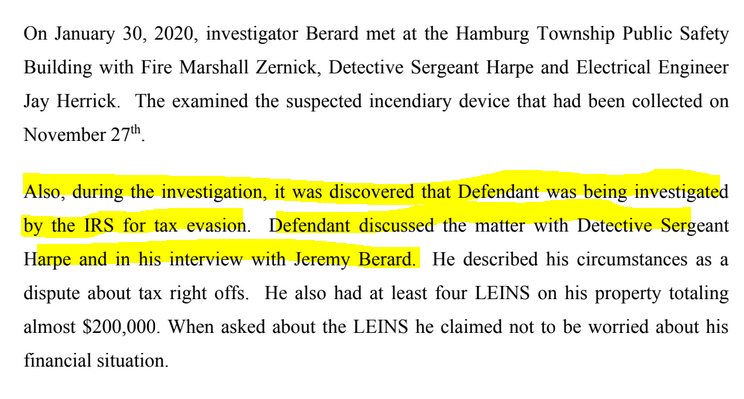
The investigation by Hamburg Public Safety continued into 2021. On March 10, 2021, Sergeant Harpe prepared documentation for the arrest of the homeowner. On 7/28/21 an arrest warrant was issued. Upon learning of this, the homeowner immediately went to the Livingston County court with his attorney and turned himself in. On August 19, 2021, the homeowner was arraigned and released on personal recognizance. As of August 1, 2024, he still awaits trial dates. However, this is not the end of his story. This was Hamburg’s part, but the homeowner initiated “Operation 232” shortly after being accused of arson, and this is where things take an eerie turn.

Tired of being manipulated and feeling targeted by acts of spite from Hamburg Public Safety, the homeowner decided to take matters into his own hands. This homeowner was not an average individual; he had retired from the workforce to spend time with his son. Managing hobbies and occasionally investing in promising companies served as a substitute for income—until the fire. After that, he decided to dedicate all his efforts to uncovering the truth behind the fire and the subsequent actions of the authorities. What he discovered revealed the inner workings of the system, and he named this endeavor “Operation 232”.
On August 11th, 2020, the homeowner joined the National Association of Fire Investigators and underwent training, becoming a member. Through this process, he learned about NFPA 1033 and NFPA 921. NFPA 1033 outlines the qualifications for fire investigators, while NFPA 921 provides a guide to fire investigations. These standards are adopted by Michigan courts as the benchmark for fire investigations.
Knowing full well of his innocence and certain that the police and fire departments were wrong, the homeowner decided to devote his time to learning about the qualifications and protocols for fire investigations. He understood that without this knowledge, he would never uncover the true cause of the fire.
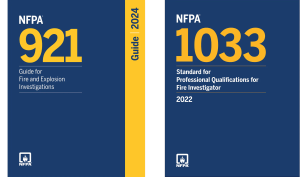
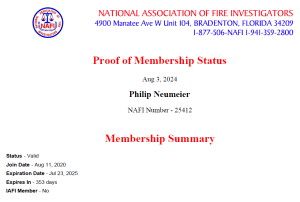
In December of 2019, the homeowner had not been arrested yet and lacked detailed information about the case, knowing only what was relayed to him on the day he was accused. He was aware that the police claimed to have video evidence, purportedly analyzed by experts, they made accusations of a blanket wrapped around a lamp put in oil inside a closet. He also knew that any available evidence had been taken by the police.
He began by reverse-engineering the scenario described during the interrogation. The police had claimed that a lamp with a blanket on it was dipped in oil and placed under the stairs in the closet, allegedly causing the fire. The homeowner knew that a light bulb alone could not ignite motor oil, but he needed to prove it. He purchased an identical photography lamps and knew the light bulb make and wattage as when was able to get back into his house in January of 2020 he found the original packaging for the light bulb. Not knowing what type of cloth was allegedly involved, he also bought several types of fabric.

Using sophisticated lab equipment from one of his companies, the homeowner conducted a series of experiments in a safe environment. He also utilized a FLIR infrared thermometer to measure the maximum temperature the light bulb could reach, both with and without different fabrics. The bulb’s max temperature couldn’t break 300 degrees.
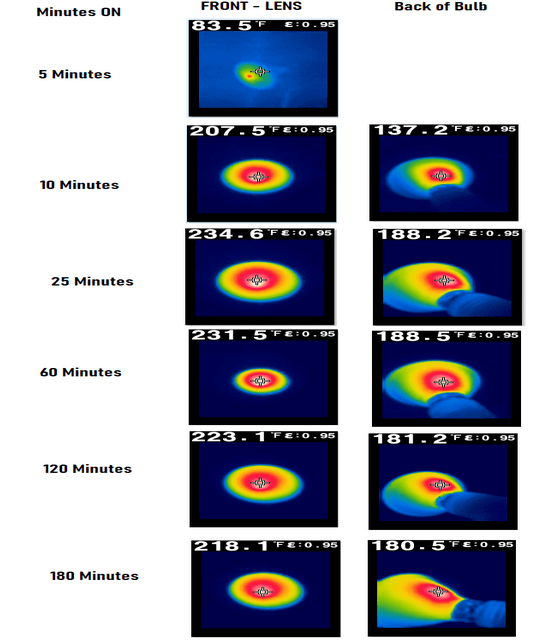
The next step was for the homeowner to test the flammability of the motor oil. Before starting, he reviewed the material safety data sheets for each item, confirming that the motor oil was non-flammable. During his interrogation, the homeowner even stated to Sergeant Harpe that motor oil would not catch fire from a light bulb. (the very purpose of motor oil is to lube and cool engines) In the preliminary examination, under oath, an investigator for the prosecution had to acknowledge the homeowner was correct. The investigator did this by stating you could hold a lighter to the oil and it wouldn’t ignite. Furthermore, the investigator conceded that the conditions necessary for motor oil to ignite the oil would have needed to be in the form of vapor. This supported the homeowners assertion and casting doubt on the initial findings of the investigation.

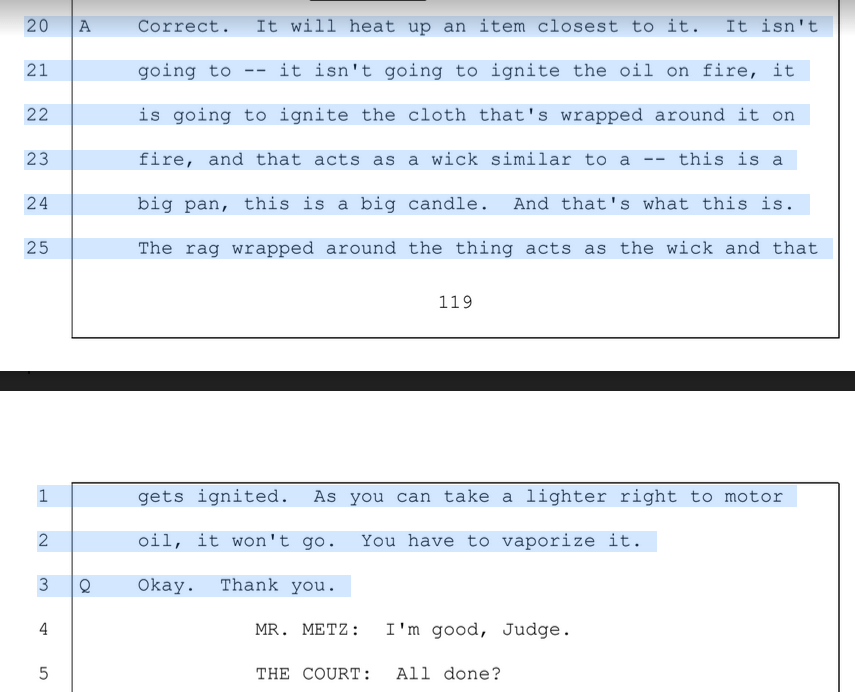
This raises the question: why would anyone scientifically believe that this light bulb could become hot enough to ignite motor oil? The homeowner’s experiments demonstrated that motor oil is non-flammable unless vaporized, which requires temperatures exceeding 500 degrees Fahrenheit. The light bulbs tested reached maximum temperatures fluctuating between 85 and 234 degrees Fahrenheit, even with the addition of fabric. These temperatures were insufficient to cause combustion. The secret lies within a critical oversight by the investigators—they did not test their theory, failing to adhere to NFPA 921 guidelines. This lapse indicates that the investigators did not follow proper scientific methodology in their investigation. The other option would be that it was never tested and investigators lied. (More on the “cloth” in a moment)
The homeowner considered the situation and realized that to achieve combustion, a higher wattage light bulb would have been necessary to achieve —nearly double the one taken into evidence. The bulb collected as evidence was a GE Brand 80 Watt/120 volt halogen bulb. However, under oath, the details changed. When asked about the wattage of the bulb by the prosecutor, the investigator claimed it was 150 watts and asserted that such wattage in a lamp could act as an incendiary device. Knowing this was a lie, the homeowner had his attorney cross-examine the investigator, who then doubled down on this false claim.

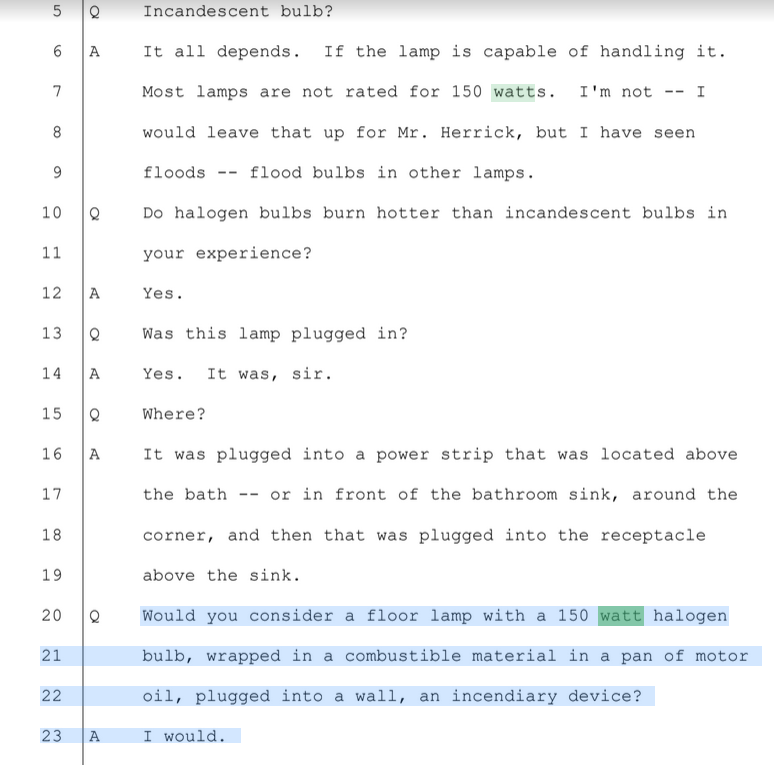
This lie was established with proof based on Hamburg Police soliciting the x-ray images and scene photographs. In their own report, they accurately identified the bulb model and wattage (80). This evidence added to the deceptive nature of the prosecution against the homeowner. Adding insult to injury, the investigator who testified that the bulb was 150 watts had been working with an engineer who visited the Hamburg Police Department. Together (investigator, engineer and police), examined the light bulb and took a picture of it, clearly showing the model as a GE 80 watt bulb. This photograph, which included the model information, further contradicted the false testimony and highlighted the deliberate misrepresentation of evidence.

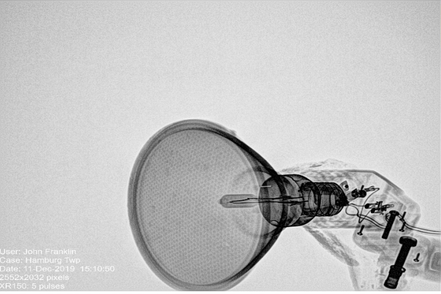
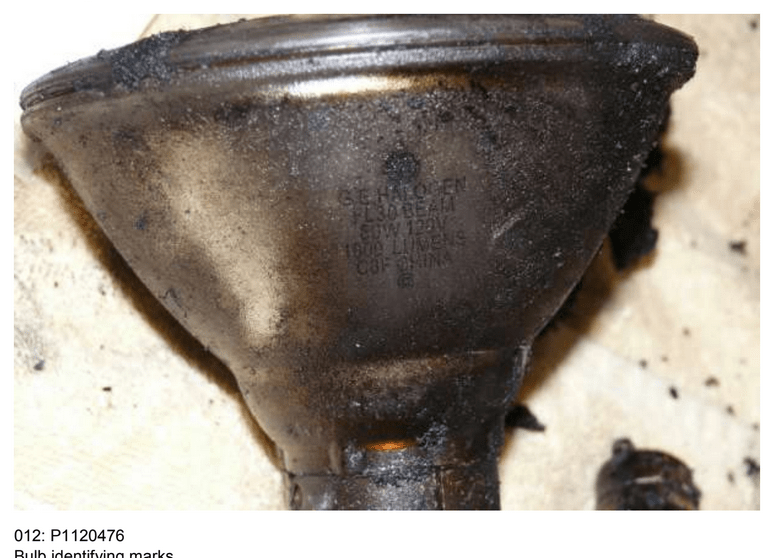
Another critical issue was the mysterious cloth, a key piece of evidence mentioned by the authorities. During the interrogation, Detective Harpe referred to it as a blanket that someone, allegedly the homeowner, had wrapped around a heat lamp. The homeowner, knowing this was not true, and calling out that there was no heat lamp vehemently denied the accusation. He asserted that he had not wrapped any cloth or blanket around the lamp, challenging the detective’s claim and raising further doubts about the accuracy of the investigation’s findings.
This “blanket” would then be referred to multiple times as “combustible material”, in an effort to push an incendiary narrative. Under testimony it changed from a “blanket” to a “rag”. The inconsistency in how this key piece of evidence was described suggested an attempt to manipulate the narrative and mislead the investigation, casting further doubt on the integrity of the claims made against the homeowner.


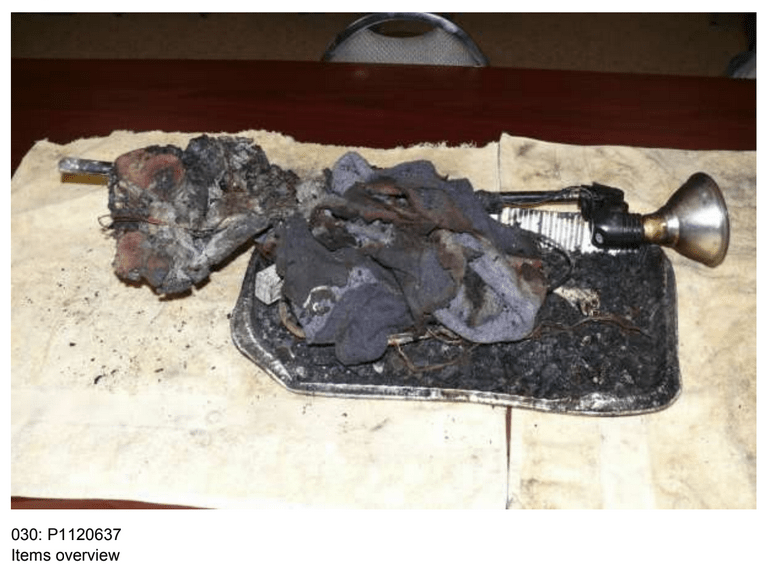
The homeowner later discovered that neither Hamburg Public Safety nor any other agency had tested the cloth in question. This lack of forensic examination raised further concerns about the thoroughness and integrity of the investigation. Eventually, through discovery photos, the homeowner identified the “cloth” immediately recognized it as a furniture pad used to protect the playing surface of a ping pong table protruding from under his stairs into the owner’s game room. Knowing the nature of the material, the homeowner was aware that these U-haul pads are typically fire retardant. He conducted control burns and determined that the material would not have caught fire from an 80-watt light bulb. Even with higher wattage bulbs, the material would melt and undergo pyrolysis without igniting, further disproving the theory that the cloth could have contributed to starting a fire under the conditions described.
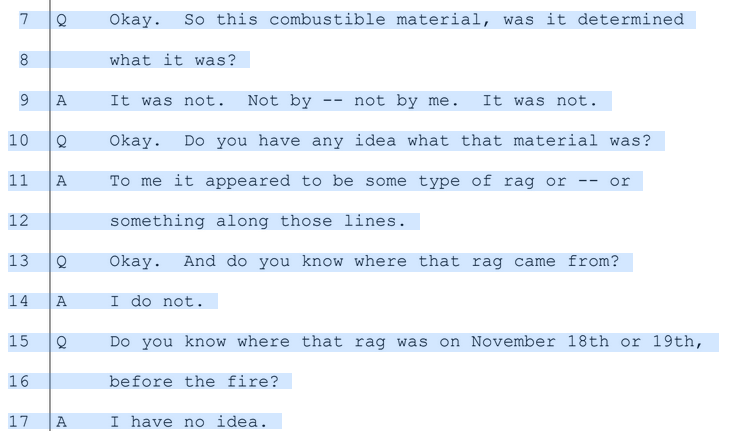

The homeowner sought additional proof and reached out to U-Haul to verify the material and flammability of the furniture pad. After confirming that it was indeed fire retardant, the homeowner was certain that it was impossible for the material to combust under any setup or arrangement as suggested by Hamburg’s hypothesis. A knowledgeable fire investigator would have recognized this fact. Yet, none of the investigators involved in the case accounted for the fire-retardant nature of the material, further calling into question the thoroughness and credibility of the investigation. As well as why anyone would testify to it’s combustibility without testing. In fairness to the insurance investigator Berard he would have not been able to test this theory as the evidence was taken by Hamburg Police. Hamburg should have tested this naturally through the NFPA 921 process.

The next critical detail involved the lamp post.The lamp in question had a metal attached base and a plastic head, and was a photography lamp post with the telescoping ability. The electrical wire was attached to the head of the lamp, this would be key data for later. One of the most astounding revelations, highlighting the lack of thorough investigation by Hamburg, it was their claim that an extension cord had been added to the lamp to extend the circuit. However, photographic evidence later revealed that what was described as an extension cord was actually a power strip.
When recreating the scene with the exact models, it became clear that even with the power strip the length of the power cord was not long enough to reach into the closet, there was also no AC outlet close enough to allow the lamp to be plugged in and positioned in the closet as testified to. This discrepancy indicated a significant oversight in the investigation, as the physical setup described was not feasible given the layout and available electrical connections.
.
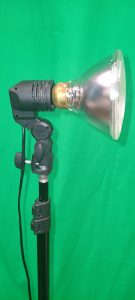
As a final blow to Hamburg’s theory that a lamp bulb could have started the fire, it’s important to note that the head of the lamp was made of plastic and showed no signs of melting when found. The plastic headpiece would have been melted or deformed in some significant way if it was the true source of the fire.
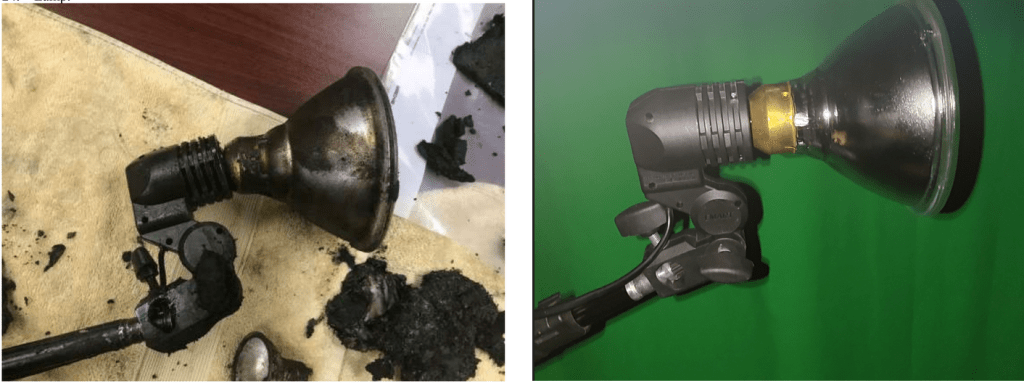
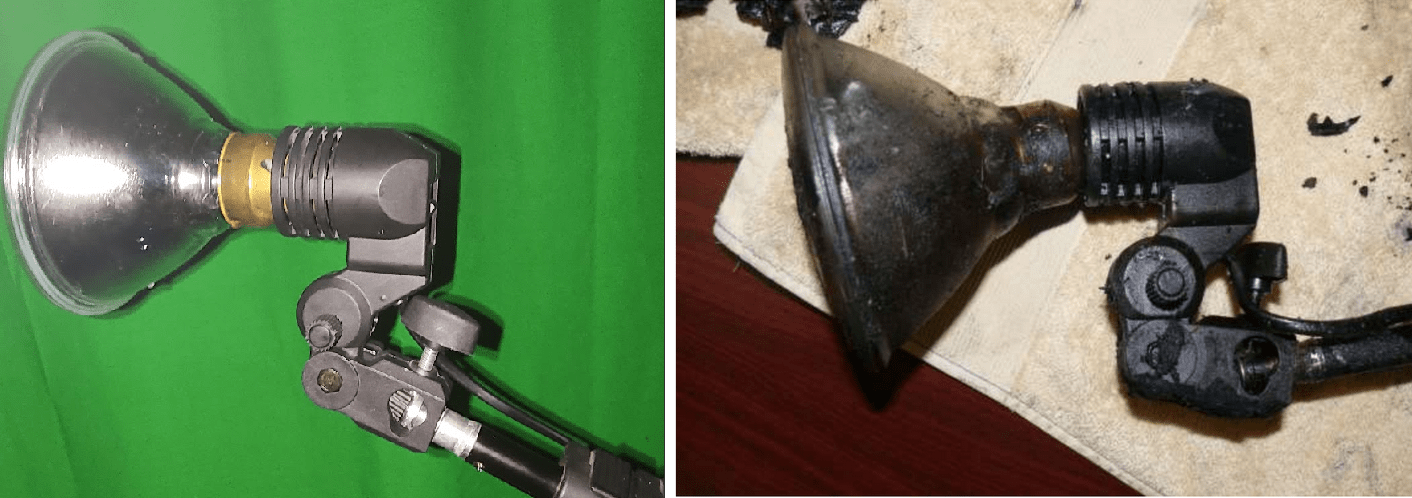
Additionally, the CE European Electronics laminated paper sticker on the back of the lamp head was found intact and undisturbed. This being the alleged source of the fire would have been destroyed. Once again any reasonable investigator would have documented and tested this.

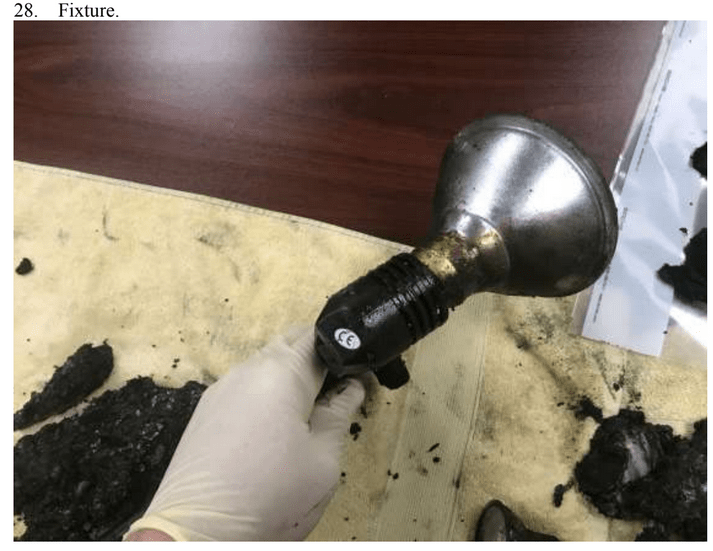
While no fire investigator has brought up the interaction between liquid and electrical components such as lamps, it is important to address this aspect as well. According to Michigan building codes, outlets must be GFCI (Ground Fault Circuit Interrupter) protected in areas where there is a risk of water exposure. Substantiated by the homeowner and supported by testimony, the lamp was plugged into a GFCI-protected bathroom socket. It was noted that no other outlets were in the vicinity, and this was the only available outlet on the wall adjacent to the area. This GFCI protection would have prevented any electrical fault or potential ignition source caused by liquid exposure, further undermining the hypothesis of the fire being caused by an electrical issue in conjunction with a combustible material.
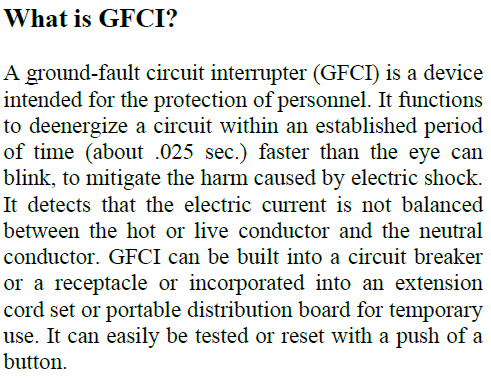


In a disturbing action, the fire marshal allowed third-party investigators from the homeowner’s insurance company into the house before his own investigation was completed. He claimed that the two investigations were independent, but evidence later showed that this was not the case. The fire marshal permitted non-government individuals to access the supposed crime scene, allowing them to move items within the origin areas, including those directly connected to the lamp, without logging what specific actions occurred and which items were disturbed. This practice violates standard procedures for evidence collection and the guidelines established by NFPA 921. Allowing unregulated access and manipulation of potential evidence compromises the integrity of the investigation and the chain of custody, raising serious concerns about the reliability of the findings.
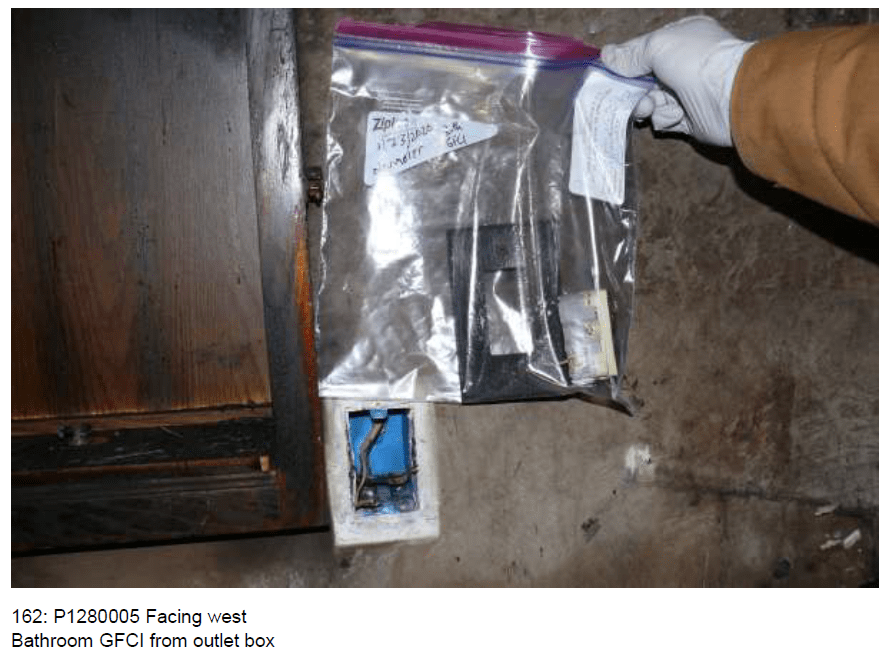
Non-government investigators improperly storing evidence in Ziplock bags. Proper evidence collection protocols were not followed, as the use of appropriate, secure containers is essential to prevent contamination or degradation of evidence. This mishandling by individuals other than the fire marshal, who should have been responsible for removing evidence, undermines the integrity of the investigation. The outlet in question was removed after the house had been returned to the homeowner, and was taken without the homeowner’s consent. This evidence, which should have been examined by state fire investigators, is now missing. This incident casts doubt on the validity of the findings and highlights a serious oversight in following standard investigative procedures. Additionally, the handling of the outlet and report provides evidence that the electrical line to the lamp was protected.
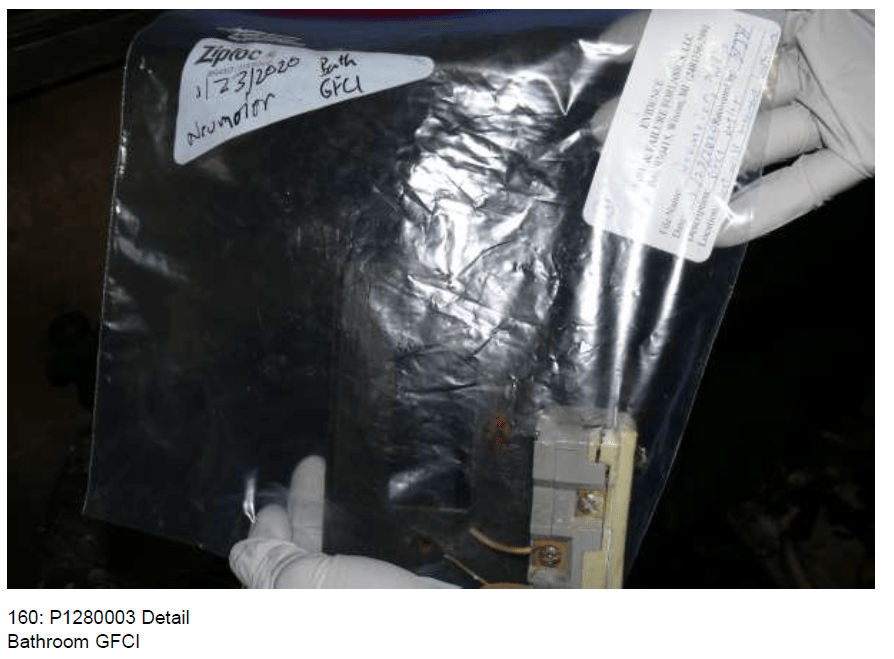

The homeowner now firmly believed that the Hamburg Fire Investigation Team either failed to conduct a thorough investigation or that corruption may have influenced the proceedings. This perspective arises from inconsistencies in the investigation, such as the identification of a non-flammable oil liquid, a fire-retardant moving pad, and an intact, unmelted light bulb as potential incendiary devices, along with an arson K9 dog not finding any accelerants. These findings suggest that Hamburg’s narrative does not align with the evidence typically associated with intentional fires, further raising concerns about the accuracy and integrity of the investigation’s conclusions.
To verify this, further testing and research were needed. After the homeowner’s arrest, a discovery file was sent to him, which included pictures of evidence and investigation reports. Leveraging one of his businesses, HubSplit.com, a beta site that uses AI and language models to process data, the homeowner took the next step.
As the founder of HubSplit.com, he utilized the site’s AI capabilities to analyze the discrepancies between the investigation reports, his own knowledge, NFPA data, and Michigan fire codes and investigation protocols. The AI system was designed to “act-as-if,” identifying inconsistencies and potential errors in the investigation process.
Through this process, the AI system led the homeowner in a direction he never anticipated. Starting with the reports by Hamburg, while I won’t cover every detail here, they are available through a FOIA request for complete transparency or on our evidence page. The gist of the reports indicates that there were two points of origin in the same room: one under the stairs in the basement closet with the lamp, and the other roughly 10 feet away on the ceiling. The arrangement in which the lamp, tray of oil, and cloth were allegedly found, combined with DVR footage of the homeowner leaving and smoke exiting the house soon after, were key factors in this case being bound over by Judge Bain.
After receiving the discovery file, the next step in the process was a preliminary exam. Having some of the discovery evidence going into the exam, the defendant was able to create a list of very important questions, which he knew would lock them in for later trial purposes. These questions, or more specifically the answers to the questions, would prove valuable to the defense.
The February 15, 2022 preliminary exam included only the state’s witnesses and not the defendant’s (homeowner’s) witnesses or evidence. This, in terms of the defense, was to get testimony on the record from the investigators involved. Bound over cases need far less evidence and are not decided by a jury. In this case, Judge Bain decided to bind the case over to trial. The homeowner was told that the case would more than likely be bound over beforehand there for introducing defense’s evidence was not needed at that time.
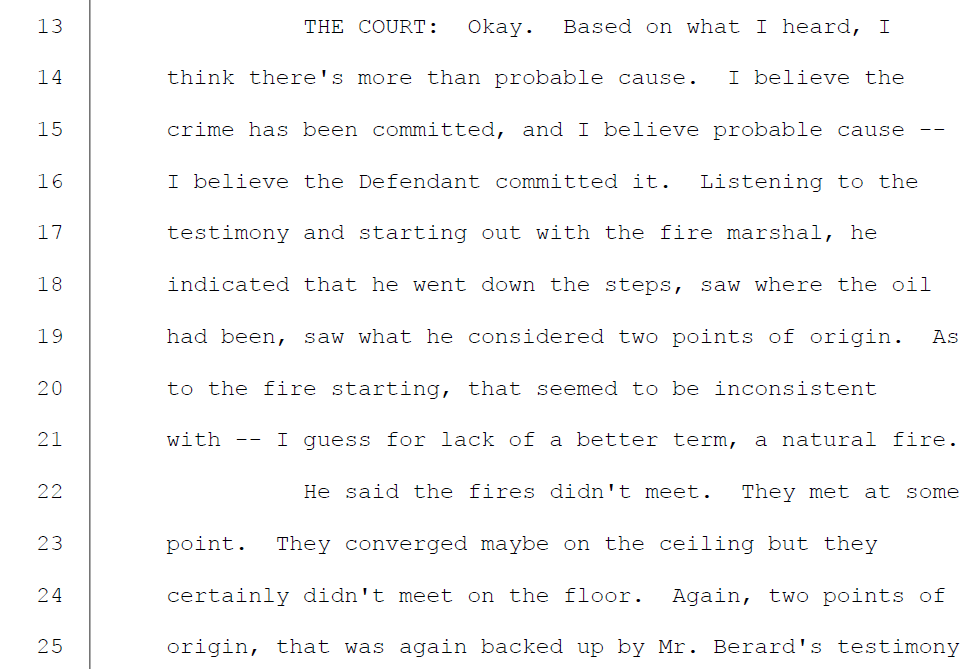
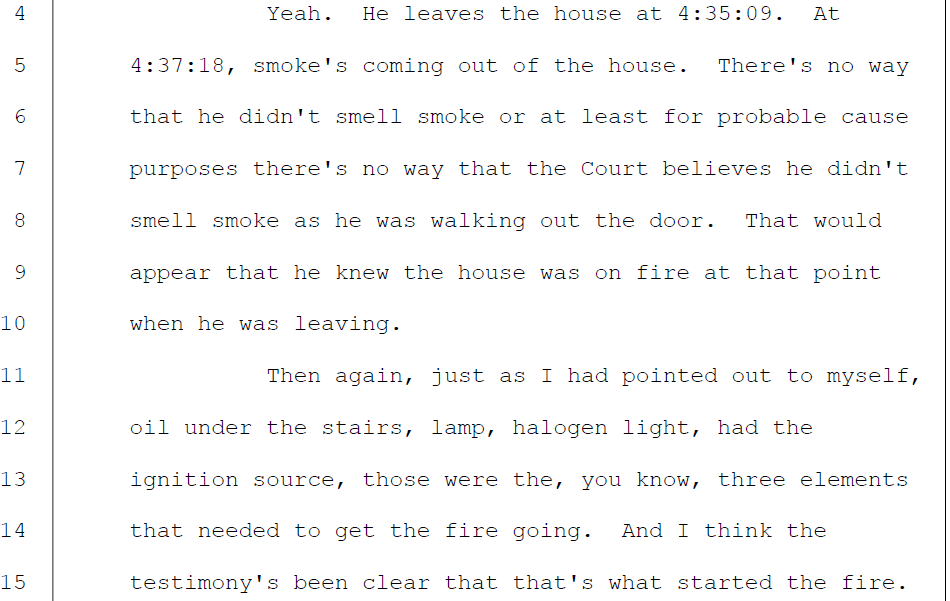
When the judge speaks, it’s important to listen. He raised three key points based on the testimony he heard from the state’s witnesses: Fire Marshal Zernick, Officer Flavin, Sergeant Harpe, and Jeremy Berard.
The first and most important point, which we have already addressed, concerns the alleged incendiary device. The next point is moot, but will be addressed later in detail: the homeowner left approximately two minutes before smoke was seen coming from the house, and it was suggested that the homeowner would have smelled the smoke. There is no evidence, witnesses, or statements indicating with any proof that the homeowner was inside the house at the time of the fire, nor can the judge know the level at which what the defendant could or could not smell. The homeowner stated in the interrogation that when he left there was no fire.
The second significant item is the alleged origin points, and this is where we will start.
The reports on the origin points conflict with one another, and the insurance investigator’s speculation that an ignitable liquid was distributed across the surface ultimately turned out to be false and untested, merely a guess due to lack of evidence.
This inconsistency further undermines the credibility of the investigation. It highlights the necessity for a thorough and unbiased examination of the evidence to ensure accurate conclusions are drawn.


Having two points of origin in close proximity does not and should not automatically indicate arson, but it does warrant further investigation. Hamburg Public Safety Origin and Cause report suggests that these origin points are not connected, raising questions about the cause of the fire. The homeowner’s mission then became figuring out how to logically connect the two points, ultimately making this a single origin fire.
Assuming we take Hamburg’s account that the fire started in the closet area under his stairs.
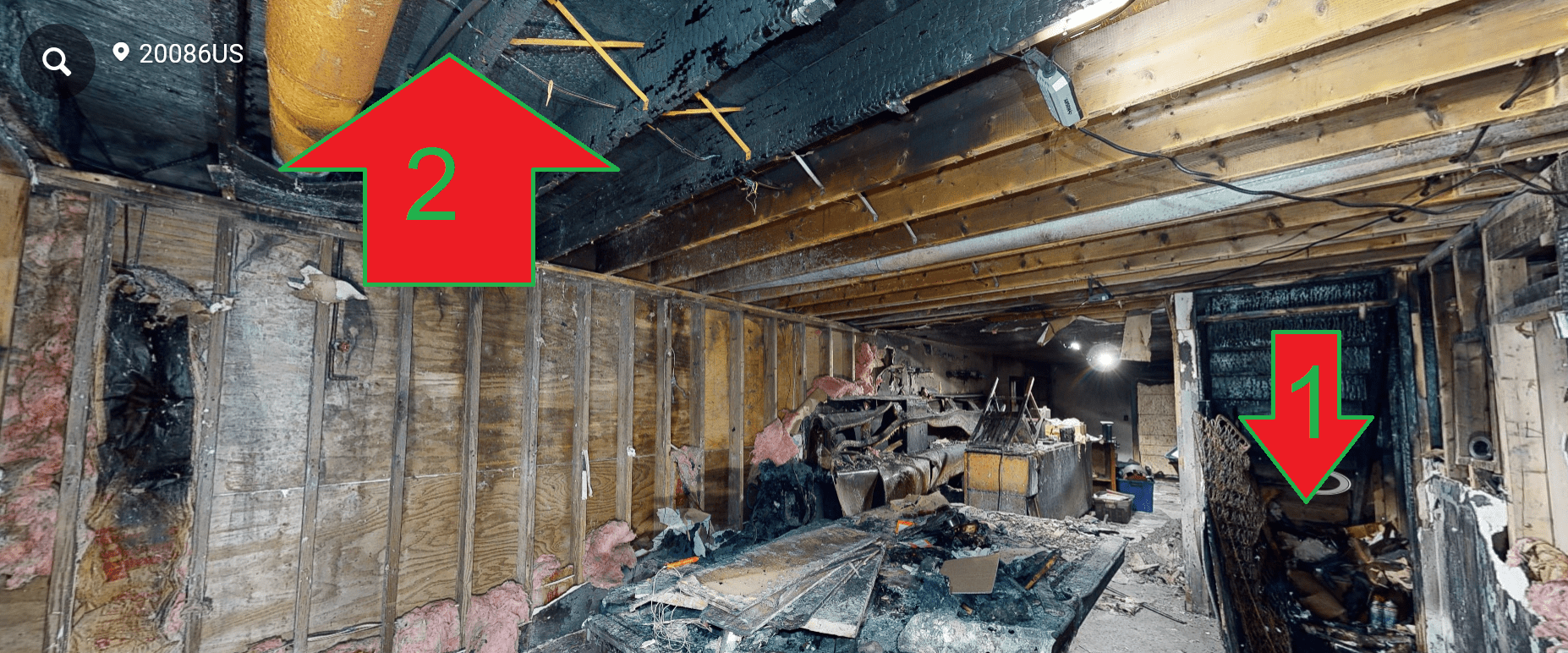
While the pictures could suggest two separate points of origin, a trained investigator would know better and test all theories first.
So, what happened? Where did the investigators go wrong? How did the investigators miss something so easy?
According to the evidence gathered by the homeowner, (and verified by investigator photos) the ceiling (suspected origin 2) showed signs of an HVAC vent pipe that became hot enough to expand, causing the drywall to break under the pressure, resulting in a gaping hole.
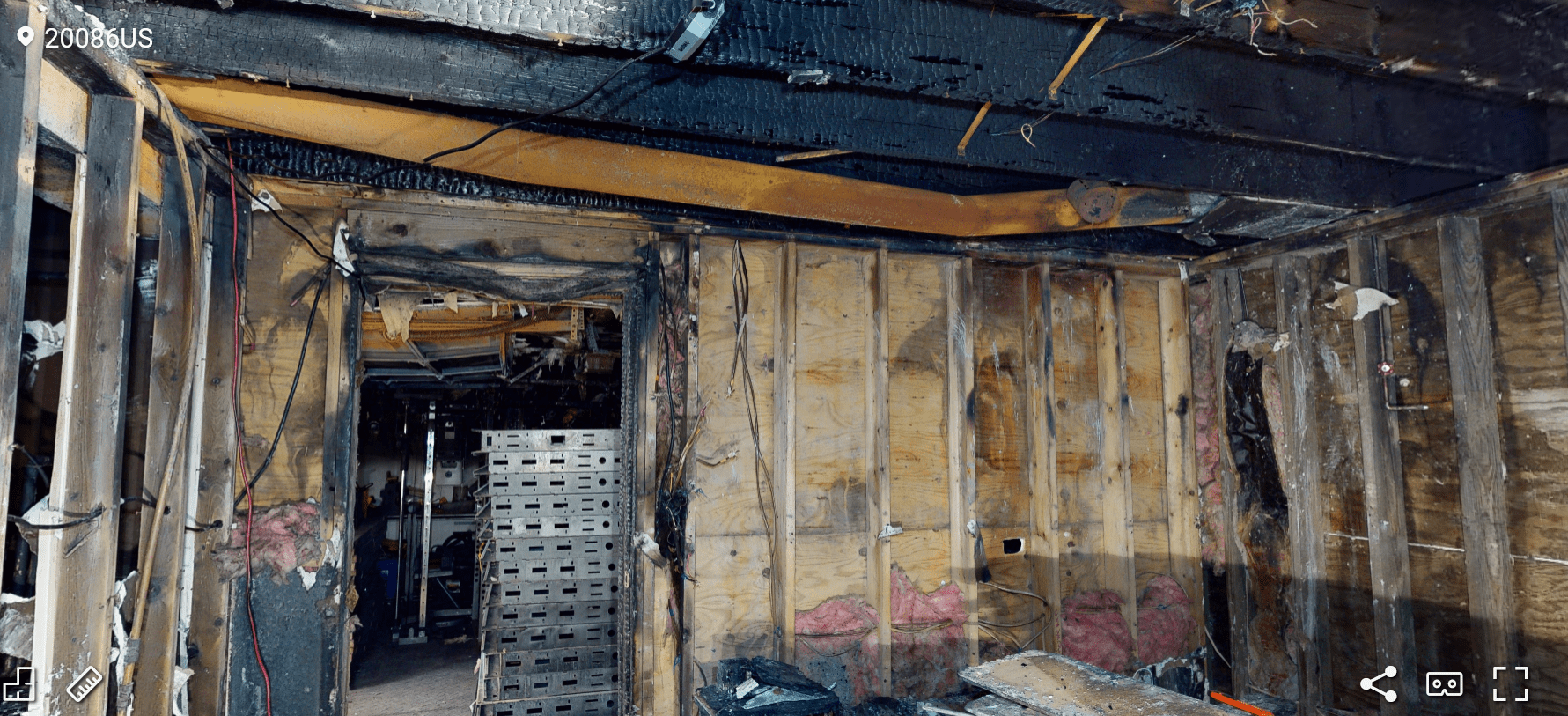
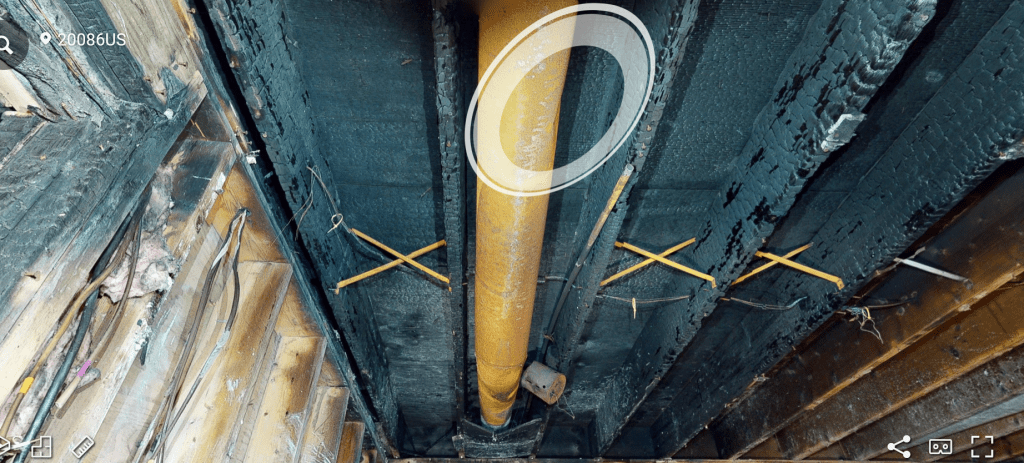
The next question is: how does an HVAC system get hot enough behind drywall during a fire to cause such an expansion? Two theories emerged, both of which are more plausible than the initial arson hypothesis. Both theories able to happen simultaneously. First, it is suspected that at some point during the fire the HVAC system was operational, as the return vents on the second floor showed soot and smoke damage on the intake, indicating that smoke was being circulated through part of the HVAC the system at some point. This could explain the spread of smoke, but there is a more likely scenario.
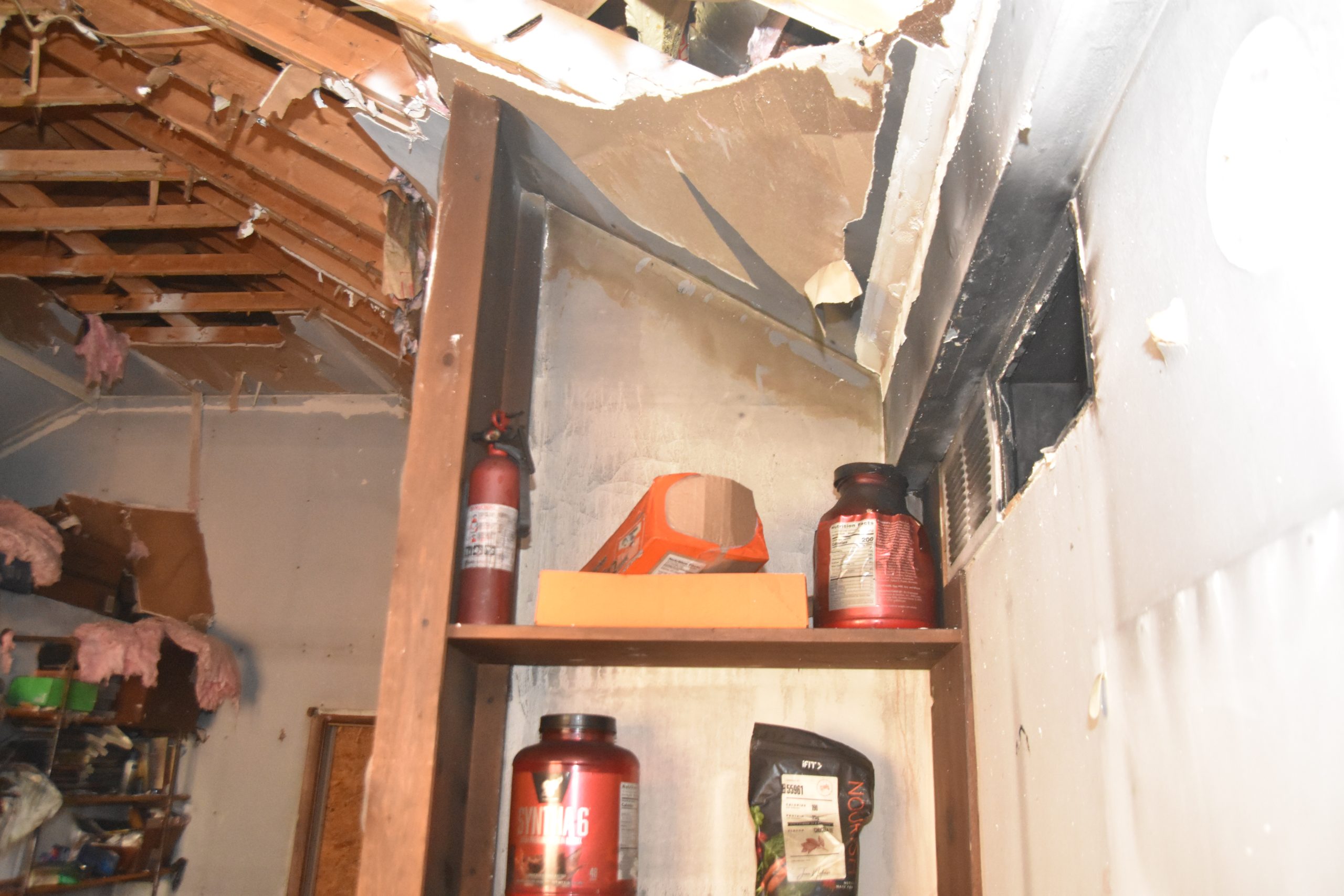
Upon deeper investigation, the homeowner considered a more nuanced factor: the presence of small, unnoticed gaps or openings. When asked, “Do you have any holes in your ceiling?” most people’s immediate response would be “No.” However, the crucial question is whether there were any small gaps or openings that could allow smoke to penetrate. These gaps, often overlooked, could have allowed heat and smoke to accumulate in areas not initially noticeable, leading to the observed damage and the false perception of multiple origin points.
In this particular case, there had once been a closet in the area where the ceiling’s origin point was identified. However, the homeowner had removed the closet to make room for a pool table years before the fire occured. The closet originally contained a recessed light fixture, which was deactivated when the closet was removed. Within the same space between the studs where the ventilation pipe was located, there remained a perfectly circular recessed light canister.
.

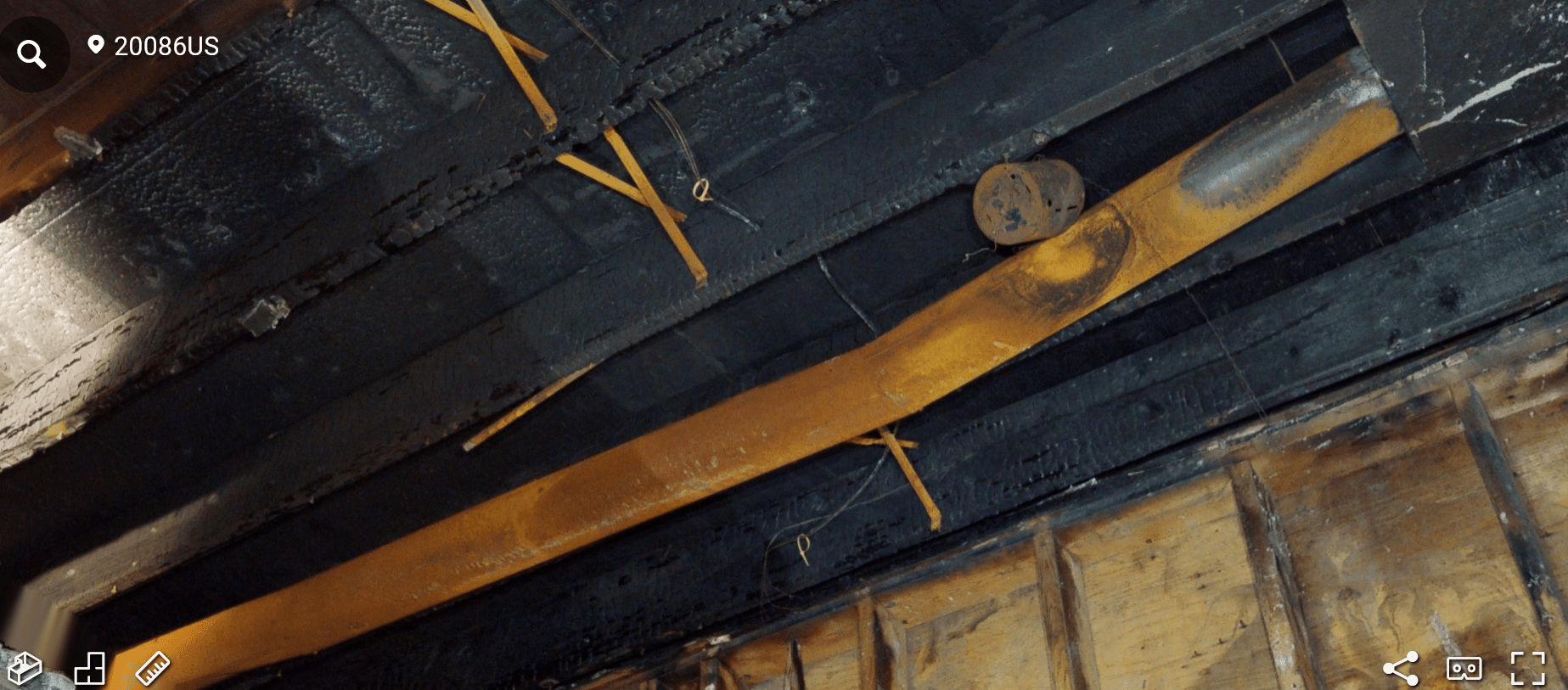
As the fire progressed, smoke would have accumulated in the cavity, causing heat to build up around the pipe. This heat caused the ventilation system’s metal piping to expand, as evidenced by photographs showing the piping pushed downward. The expansion and subsequent pressure led to the drywall collapsing, creating an opening approximately 3-4 feet wide at minimum when the drywall sheet collapsed. This would have caused the drywall to fall on top of the pool’s eastern edge and in front of it on the floor.
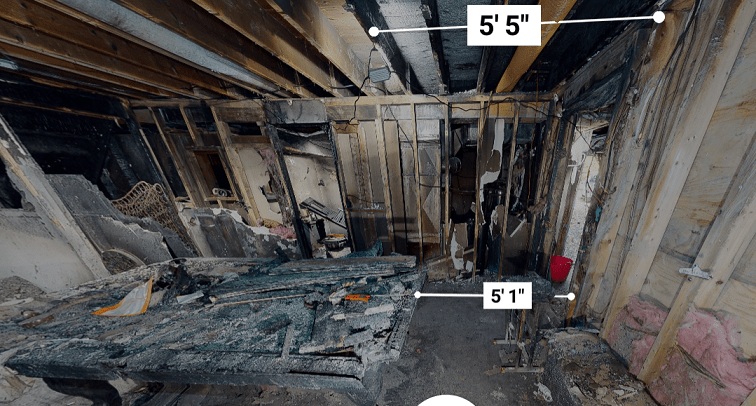

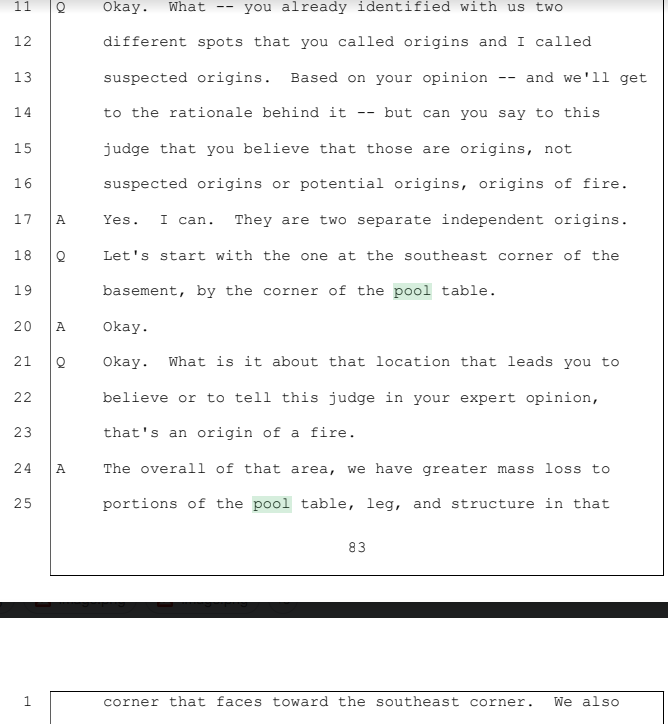
Ironically, during testimony, Investigator Berard mentioned that the ceiling would have needed a 3-4 joist-sized hole to account for the amount of damage the alleged origin point had sustained. This statement inadvertently supported the homeowner’s theory, confirming that the ceiling collapse was not a separate origin but a result of the fire’s heat affecting the HVAC and light fixture area. Furthermore, Berard mistakenly identified the direction in which the joists ran; in reality, the joists were perpendicular to the pool table, as seen in photographs. The homeowner thus demonstrated that the incident involved a single-origin fire, with the observed ceiling damage being a consequence of the initial fire’s effects, not evidence of multiple origins..

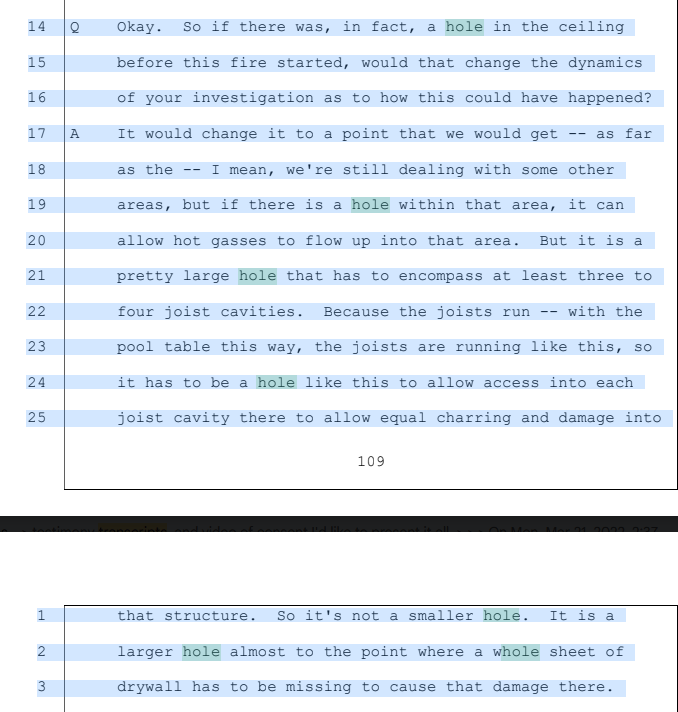
The homeowner’s AI analysis, conducted before the preliminary exam, helped create a list of questions designed to elicit truthful responses from the witnesses. Additionally, the testimony by the fire investigator clarified and explained the phenomenon of the pipe expanding due to the heat and hot gases.
This targeted questioning and the fire investigator’s detailed responses were crucial in highlighting the inconsistencies and gaps in the original investigation. By focusing on the physical effects of the fire, such as the expansion of the pipe, the defense aimed to provide a more accurate and scientifically sound explanation of the events in future trials, challenging the prosecution’s narrative and reinforcing the importance of proper investigative procedures.
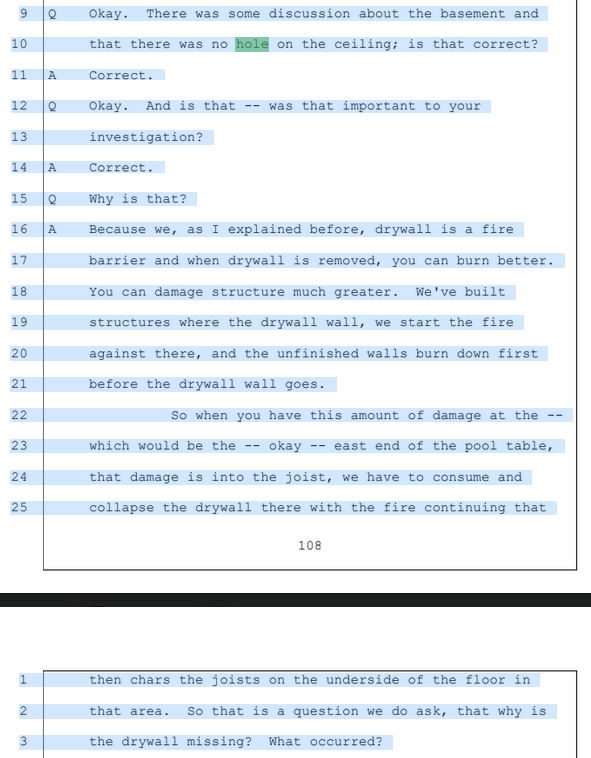
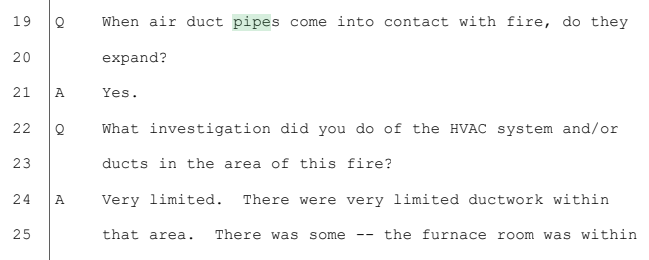
The Fire Marshal’s report documented that the cold air return allowed smoke to travel to the top floor of the house. This air returned connected to the same joist that was housing the vent pipe, which expanded due to thermodynamics. This provides a plausible explanation for why smoke was seen coming from the upper portion of the house. The smoke could have traveled up into the roof and out through the eaves. The gap allowed the smoke to travel up the studs into the homeowner’s son’s room, which also contained the attic entrance within the closet, providing direct access to the attic and allowing for ventilation of smoke outside the house.
The passerby who called in the fire noted the smoke coming from the home, while the homeowner stated there was no fire or smoke when he left. Video camera footage shows no smoke exiting the house as the homeowner left. It wouldn’t be for approximately two minutes that footage of smoke can be seen. A theory arises when considering the smoke traveling between the joists and up through the walls: if the fire was occurring within the house, it could have been without the homeowner’s knowledge and explain the timing of events.
This scenario aligns with principles found in NFPA 921, which discusses fire behavior and movement through building structures. Understanding the pathways and ventilation points, such as cold air returns and attic access, is crucial in determining the fire’s origin and spread. Additionally, NFPA outlines the need for fire investigators to consider all potential causes and pathways of smoke and fire when conducting their investigations.


So, how did the fire start in the first place in suspected origin one? And were they truthful about the lamp being in the closet? Let’s start with the lamp. I approached this question with a “MythBusters” mindset, attempting every possible way to recreate the scenario they described. Despite my efforts, it could not be replicated in the manner they claimed, or even close to it.
Let’s wrap up the lamp and how it could have been possible to be found in the pan at the time of the fire.
First, it’s important to understand the layout and contents of the closet in question. The closet’s door was removed long before the fire so it was in essence a storage space. This closet was used to store miscellaneous items around the house that didn’t have a designated space. It contained camping equipment, old business materials, chairs, a mattress, ping pong tables, an older dartboard, and other assorted items. There was nothing unusual or out of place in the closet, except perhaps for the fire department’s eventual involvement.
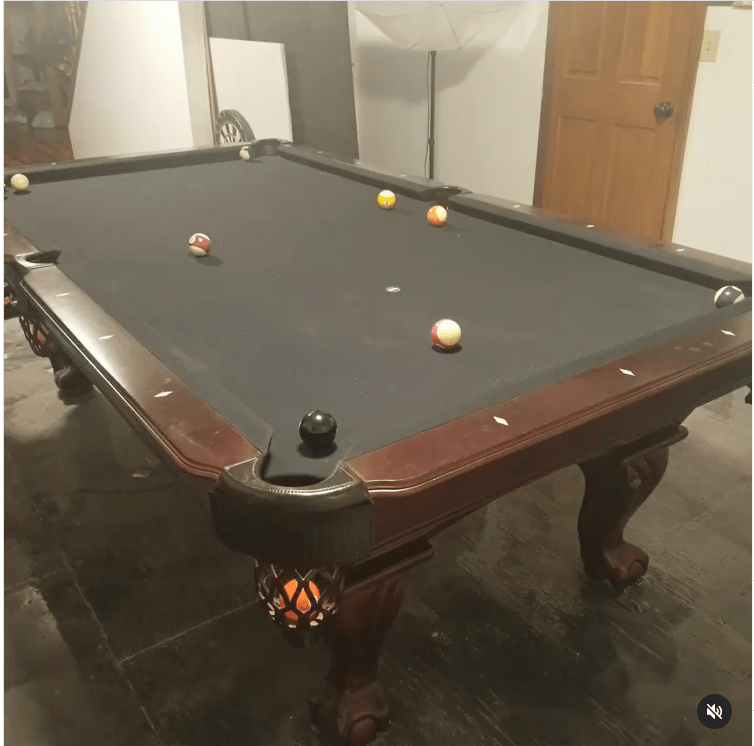

Inside the closet, right at the threshold, was a chair with it’s front facing legs right outside the threshold entering the game room. There was a storage bin placed on top of the seat. In front of the closet, outside the threshold, was the location of the tray. The lamp would have been standing upright behind the bathroom door, which was connected to the same wall as the closet. When the bathroom door was opened, it swung out into the basement area, positioning the lamp right behind the door. Further down, across from the closet, was the door leading to the garage. Investigators claim they found the pan under the stairs within the closet at one point claiming they had to be on there hands and knees.
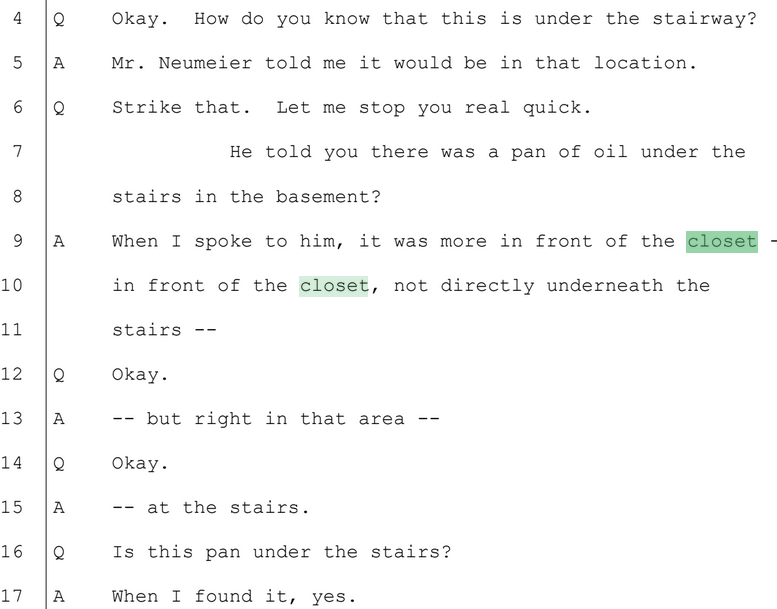
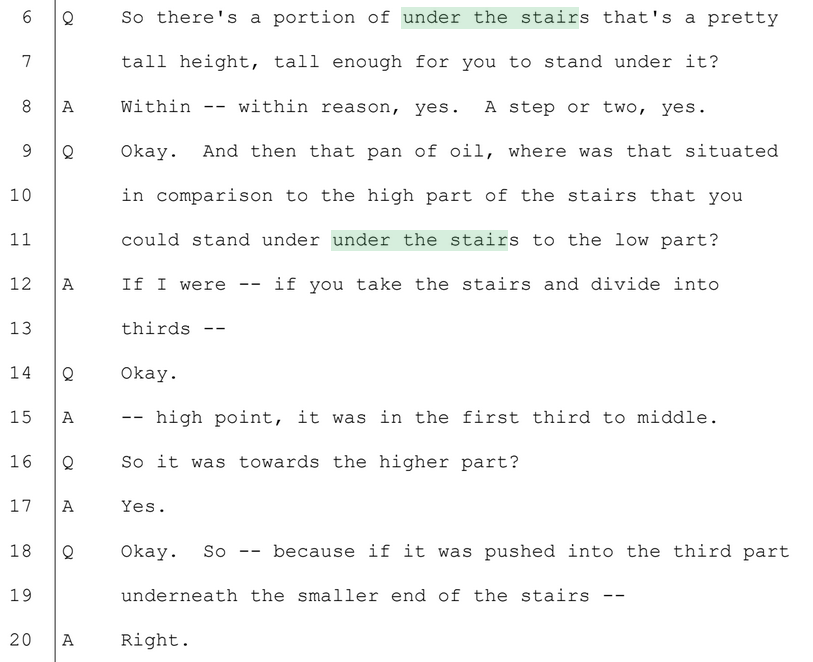
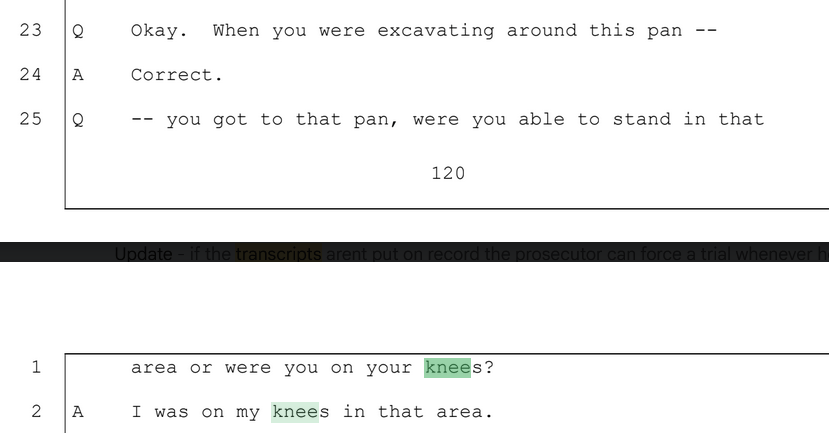
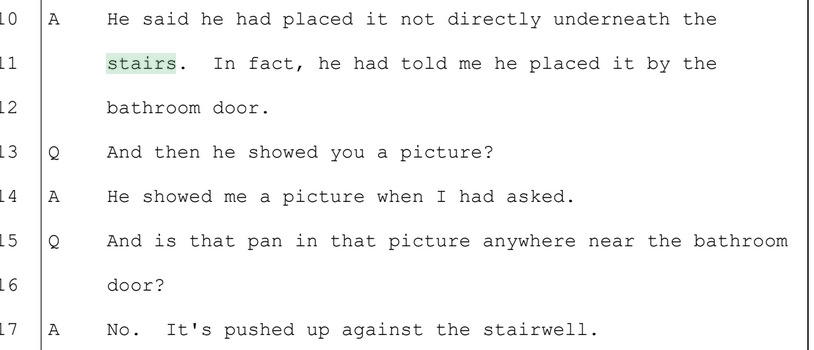
These statements would all be untrue, as during the investigation, the Fire Marshal took photos that contradict everything said regarding the tray of oil under the stairs in the closet. The photographic evidence directly challenges the claims made about the origin and behavior of the fire, further highlighting the discrepancies and potential inaccuracies in the investigation’s conclusions.
This contradictory evidence underscores the need for a thorough re-evaluation of the case, as it casts serious doubt on the validity of the initial findings and the reliability of the testimony provided by the state’s witnesses.
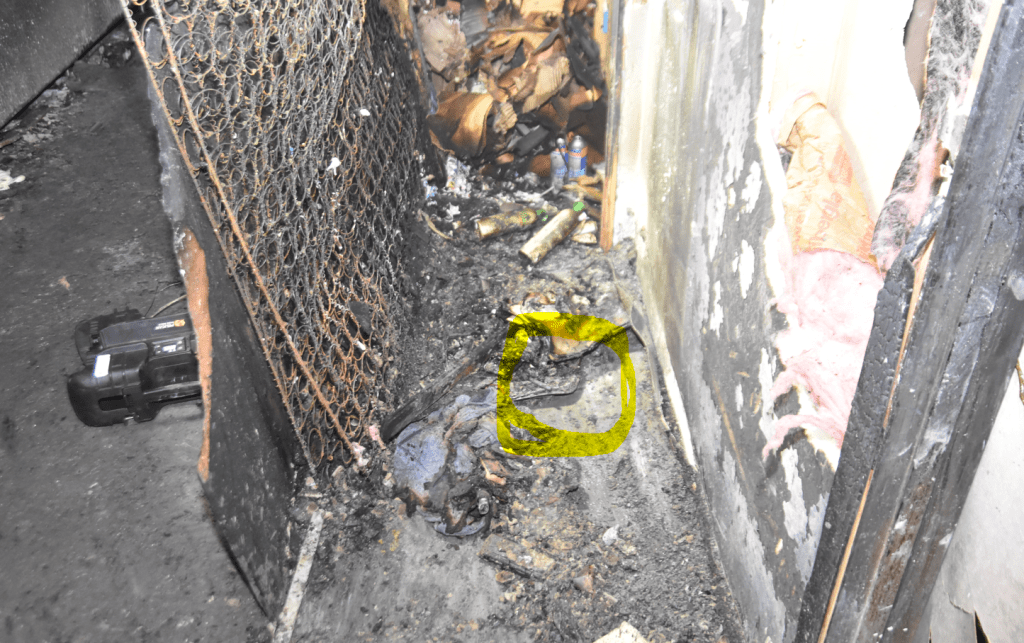
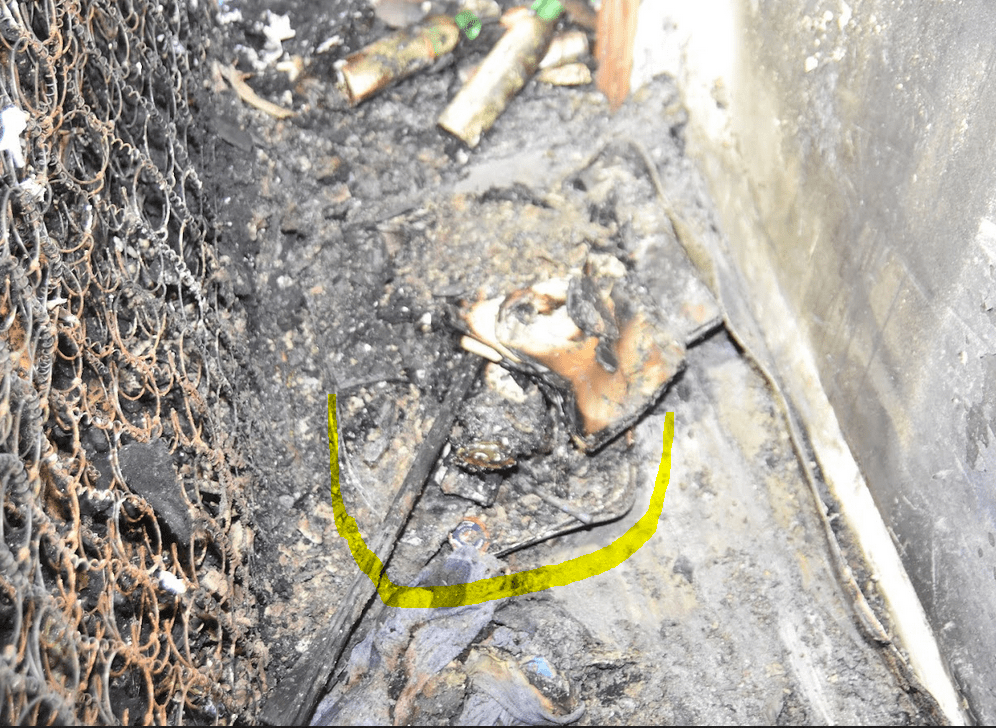
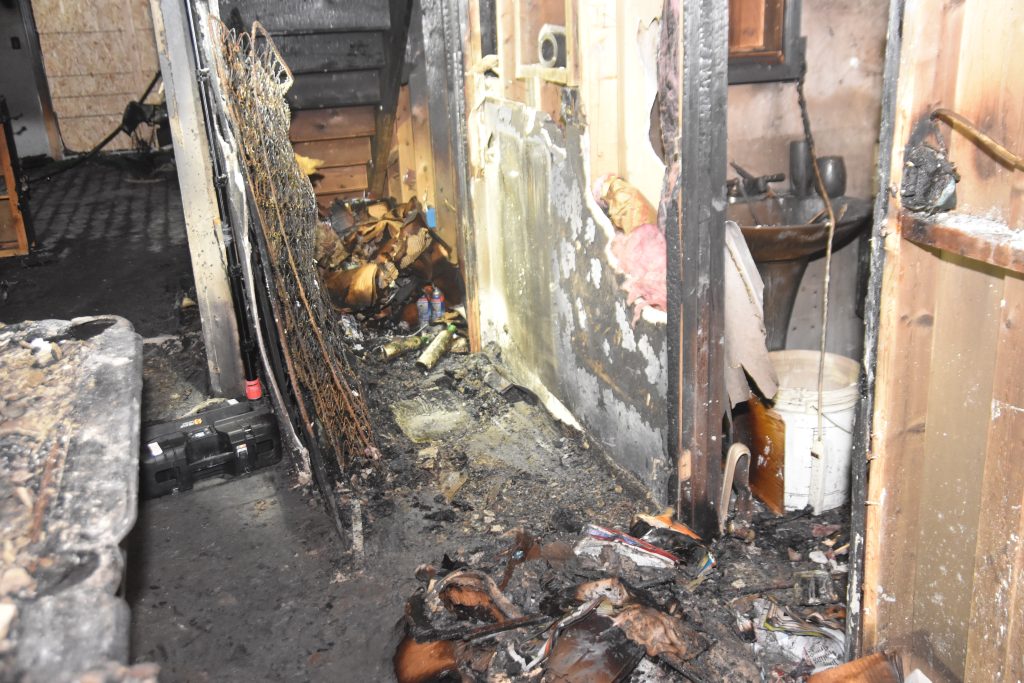
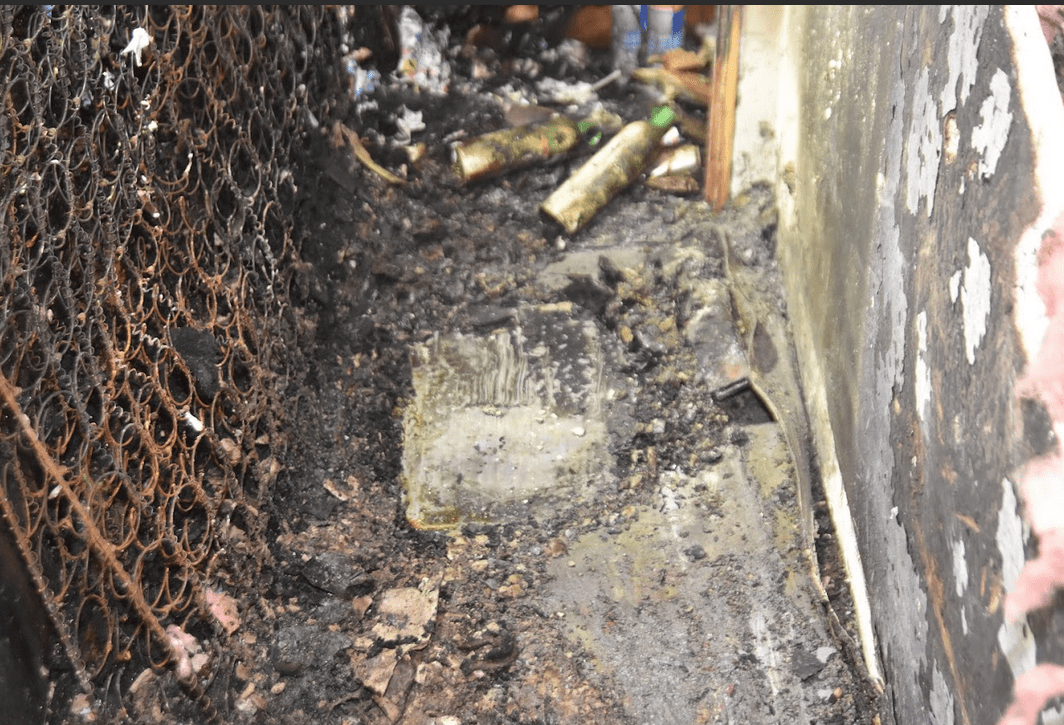
The homeowner stated that he placed the tray near the bathroom door, not under the stairs. The bathroom door would have had to be open to have a path for the lamps cord. This would make the tray’s location by the bathroom door as stated. He provided a picture to his roommate showing the tray near the closet door’s threshold, clearly indicating in front not within the closet. This photo, which the homeowner showed to Officer Harpe and the investigators, directly contradicts the claim that the tray was under the stairs within the closet.
This discrepancy is crucial because it challenges the accuracy of the fire investigation report and suggests that the initial conclusions about the fire’s origin incorrect. The homeowner’s evidence shows a different location for the tray, which could significantly impact the interpretation of the fire’s cause and progression.
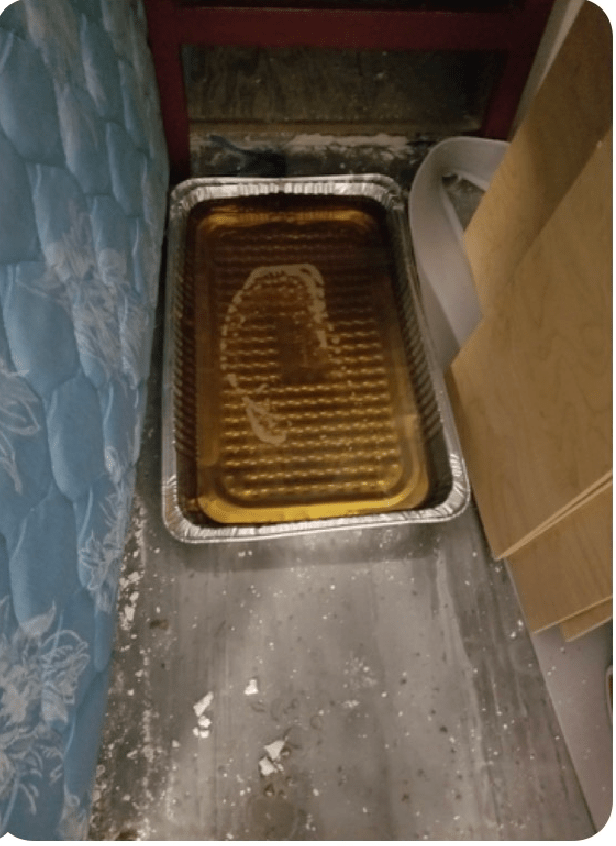

In the photo sent by the homeowner via text to his roommate, you can see the maroon chair legs coming out of the closet past the threshold. This detail is important because, in the next photo, you can see the chair after it was removed. The issue is that this chair was removed well before the examination of the origin point under the staircase by insurance investigator Berard. This indicates that before the insurance investigator was involved, Hamburg personnel removed debris from the origin point, thereby disturbing the area. Additionally, they would have had to be standing on debris over the pan to pull this chair out from under the stairs. This could explain the the pan appearing collapsed.
This action suggests that the scene was altered prior to the formal investigation by insurance investigator, potentially compromising the integrity of the evidence and the findings related to the fire’s origin. Such interference raises serious questions about the accuracy and reliability of the subsequent investigation conducted by the fire marshal and the insurance investigator.
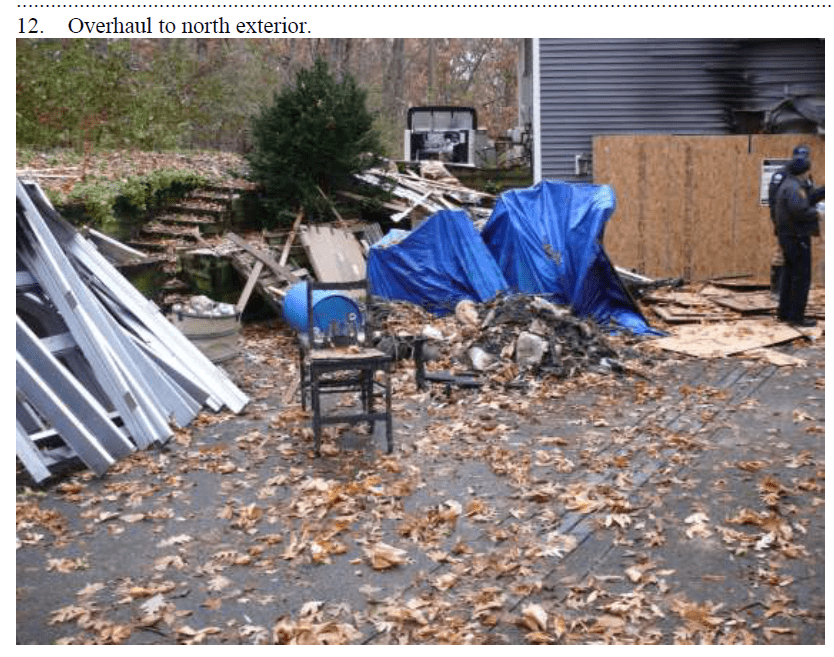
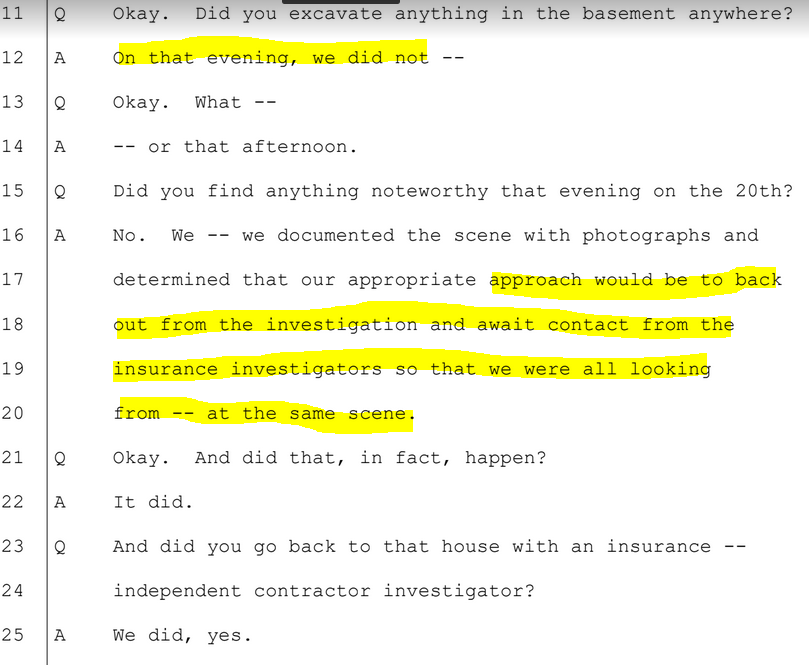
For the lamp to have ended up in the pan at the time it was retrieved, a far more plausible explanation over incendiary means is that it would have initially been standing upright where the homeowner said it was behind the bathroom door, with the tray located in front of the closet, not inside it. (as stated by the homeowner, by the open bathroom door and tray excavation photos) Given the insufficient length of the cord to reach the closet, the lamp could not have been placed under the stairs as testified to by investigators. The cord would have had to been unplugged or severed to reach in to the closet where investigators testified to finding it (despite their own pictures and evidence contradicting this). If this were the case a severed wire could have caused the door to catch on fire, collapsing into the lamp knocking it into the oil tray.
*The possibility of the bathroom door collapsing onto the light has not been ruled out nor was it even checked by investigators; however, we are working with the data provided by the investigators to ensure the best alignment with their discovery file and evidence.
The length of the power cord and the power strip is not long enough, which the investigators did not test for some reason. Testing the cord length would have quickly resolved the discrepancy and clarified the lamp’s possible location, potentially negating the claim that it was part of an incendiary device setup.
This oversight by the investigators is significant. This revelation aligns with a more plausible scenario.
Testimony and reports suggesting the lamp was plugged in at the time of the fire and intact.
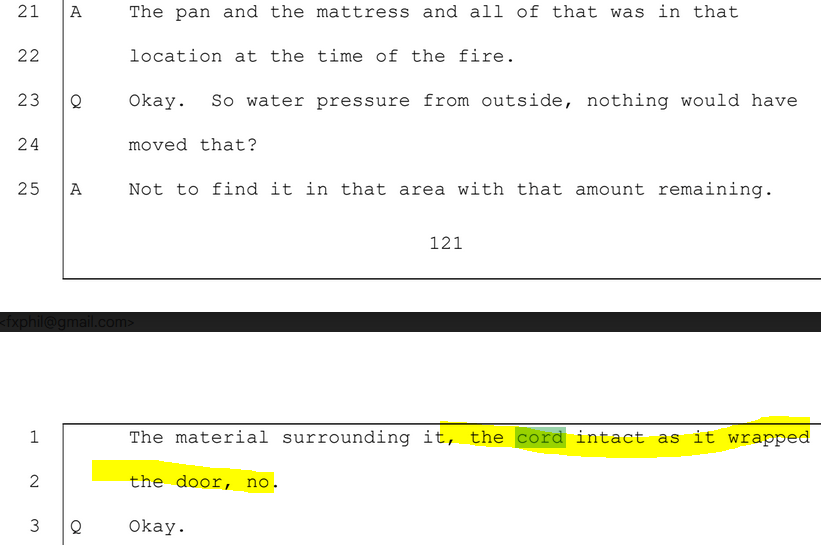

Another important detail to note is the angle of the lamp bulb. The light bulb head was found aiming 90 degrees, with a slight bend in the neck. A more plausible theory is that the force of the fire suppression efforts was strong enough to knock the bulb and lamp head into the ping pong table, or other item/s altering its alignment and causing the bend in the neck.
This explanation fits with the chaotic nature of fire suppression, where water streams and other actions can easily displace objects and change their positions. The misalignment and damage to the lamp support the idea that the lamp was affected during the suppression process, rather than being deliberately positioned as part of an incendiary device setup.
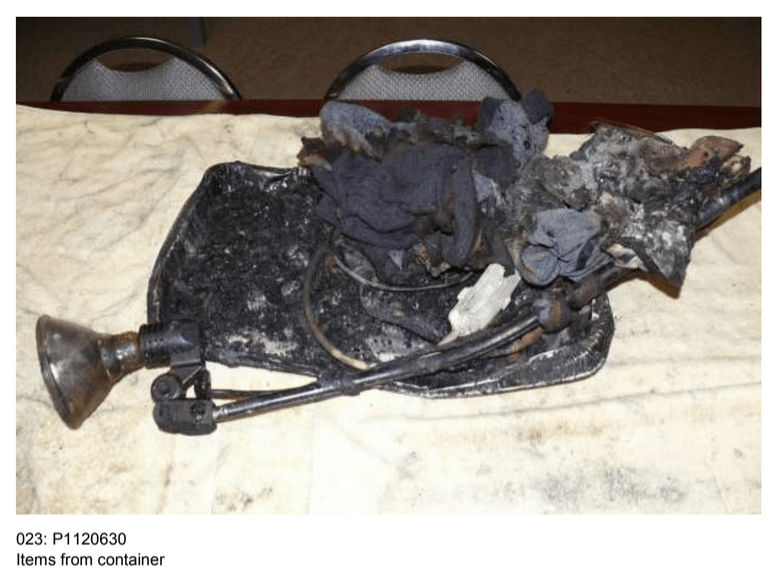
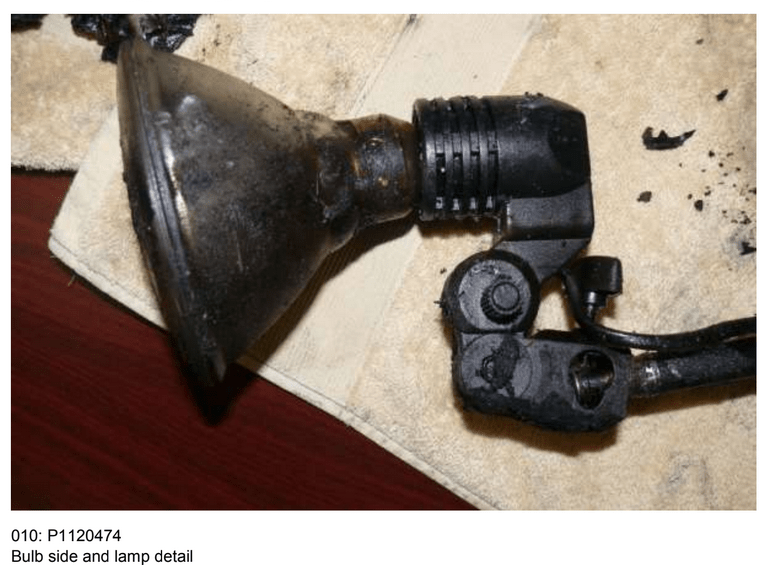
During the interrogation, Sergeant Harpe made a comment that stuck with the homeowner: “Lamps don’t just fall on their own.” He was correct. The most plausible theory is that when the fire department entered the house through the garage, they saw the fire’s origin point (area near the closet) and sprayed it with a 3-inch water hose. With a pressure of 200-300 psi, this hose has enough force to knock over a lamp and potentially displace objects. For context, the force from such a hose can knock over a 200-pound person, as per the formula (F = ρ × Q × V).
The lamp and bulb weigh less than 5 pounds, making the lamp top-heavy due to the type of bulb and neck piece. This top-heavy design means it would have been easily knocked over during fire suppression efforts.
Fire suppression efforts would have been focused directly on the closet adjacent to the garage entrance, which is where the firefighters first entered the house.
This force likely knocked the lamp over towards the closet area. The cord would have limited how far the lamp could go. The lamp, hitting the ping-pong table and mattress area where the furniture pad that was protecting the playing surface side of the pong table, could have then landed in the tray. As the firefighters sprayed closer to the floor, the lamp and tray could have been pushed under a chair too and into the closet but we also now have proven the tray was not found under the stairs as testified to and as seen in investigator recovery photos. (This was a theory of the homeowners at the time before getting scene photos) The chair in the closet less it’s front legs protruding over the threshold had a bin of items on top that could have collapsed on top of the lamp.
With the the fire retardant furniture pad now protecting the lamps head and neck it would explain why it was found in good condition, with no signs of melting, and the CE sticker on it remained intact. If the lamp had been involved in an electrical fire, we would expect to see significant damage and arcs.
Furthermore, the light bulb was X-rayed and found to be functional, which wouldn’t be the case if it had shorted out or been exposed to fire damage. No short would have happened as it was plugged into a GFCI and powerstrip.
Now, addressing a smaller but curious detail: why was the lamp plugged into the bathroom wall outlet and led out into the basement? The simple answer is that there were no outlets on the entire wall of the basement where the lamp was located. The bathroom outlet was the only one available on that side of the room, necessitating the use of an extension power strip to power the lamp in the pool room.
This effectively rules out the Hamburg narrative. So, how did the fire investigators miss such crucial clues? It appears that they were either fixated on proving arson, becoming blinded and biased by their initial assumption of 2 origins, or they were intentionally trying to pin an arson on someone. One would expect that simply adhering to NFPA 921, the standard guide for fire and explosion investigations, would have been sufficient to uncover the truth. Since the origin scene was disturbed by proof of the chair being removed before the insurance investigator got there it shows that he was not looking at a scene undisturbed and previous investigators were indeed moving items beforehand. It would show that testimony of the fire marshal waiting to go in and exam with the insurance investigator was not true.
However, fire investigation requires more than just following procedures and extensive training; it demands a thorough and unbiased examination of all evidence. It was discovered during testimony and through a records search by the homeowner that the Hamburg Fire Investigation Team does not have a certified fire investigator on the team. This revelation raises significant questions about why they were conducting the investigation instead of certified professionals.
The lack of certified investigators undermines the credibility of the investigation and calls into question the validity of the findings. Proper fire investigation requires specialized knowledge and training to accurately assess the origin and cause of fires. Without certified personnel, there is a higher risk of errors, misinterpretations, and overlooked evidence, all of which can compromise the integrity of the investigation. The Homeowner reached out to Michigan Licensing and regulatory affairs. To no surprise no records exist.



If Hamburg had a certified Fire investigator the would know that NFPA 921 directs an unbiased investigation and that when the alleged incendiary device was found it should be investigated along with all other options. The outcome would have been certainly different if they would have contacted Michigan state police fire investigators from the start. They were never contacted to conduct an origin and cause investigation.
For the longest time from November 2019 until now the homeowner has been dragged through the dirt, they manipulated consent form use, even staged the homeowner’s home and they manipulated the homeowner into an interrogation under the guise of 10-20 min meeting about his notes, they sent inspectors to his office in an effort to penalize him, and disrupted his holidays even made up bold face documented lies about being investigated for tax evasion. The homeowner wouldn’t put it past them to engage in small-town cover-ups to protect themselves. However, he kept wondering: if they were covering up, why go to such lengths? It would be highly unprofessional, especially for fire investigators, and unnecessary if it was just an honest mistake.
Determined to uncover the truth, he revisited the discovery file, convinced that if they were lying, the data wouldn’t be found in it but maybe something would stick out. He also knew that the prosecution had access to more information. He was not suggesting that they hid information, as withholding evidence pertinent to the case could be illegal. However, it became clear that they might not have had all the data available to them, actually it’s clear they didn’t because he was accused and charged, but the missing data is exactly what he uncovered.
This is where Operation 232 takes a deep twist. The investigation conducted by the homeowner revealed more than just procedural oversight or negligence—it suggested a deeper level of misconduct or deliberate wrongdoing. The homeowner’s findings raised serious questions about the intentions and integrity of the investigation team, prompting further scrutiny and analysis.
At this point, after disproving the narrative, the homeowner sought to understand why the Hamburg investigation team considered this an incendiary fire. He questioned whether they had set him up, whether they were covering their mistakes by blaming him, or if there were other reasons behind their actions. The homeowner pondered why the investigation took so long and whether he had unknowingly angered someone in the town. These questions drove him to dig deeper into the motives and actions of the investigation team, seeking to uncover the truth behind their seemingly unfounded accusations.
The homeowner went through all the data again—every word, every text, every email, every log, report, and video was scrutinized. What he found was that Hamburg Public Safety had staged his house, specifically his son’s bedroom. He discovered this via body camera footage of Officer Flavin, testimony, and the presence of one fire escape ladder.
The homeowner had a fire escape portable ladder in a cardboard box in his bedroom closet. This ladder belonged to the homeowner. However, during the fire, it was taken out of the box, brought to his son’s room, opened, and placed on his son’s bedroom window. This was beyond odd, as the homeowner did not do this before the fire, suggesting it was staged by Hamburg Public Safety.
Body camera footage from the first arriving officer Fischahber shows a clear view of the homeowner’s son’s top floor window, which was closed. The homeowner was not at the house at the time and was mandated to stay at the bottom of his driveway upon his return.
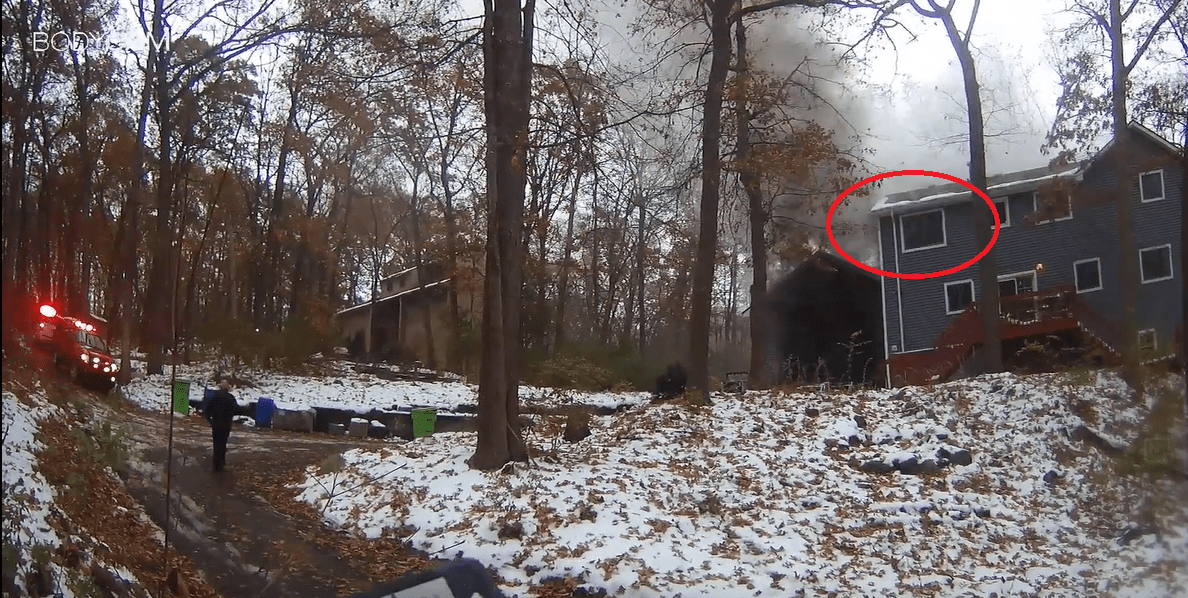
Later on, while the homeowner was still not allowed in the house, Officer Flavin’s body camera captures a brief moment—lasting less than a few seconds—he also verbally acknowledges the ladder. This footage shows the ladder hanging from the window, further indicating that it had been moved and staged by someone other than the homeowner. Officer Flavin can be heard saying “there’s that fire ladder we were looking at”
This moment is crucial as it provides visual evidence that the fire escape ladder was indeed relocated and deployed in the son’s room without the homeowner’s involvement. The ladder’s position, combined with the homeowner’s account and the body camera footage showing the closed window upon the officers’ arrival, supports the claim that the scene was altered.

This fire ladder was in a box in the homeowner’s personal bedroom, never opened. How could it end up in his son’s room, opened and hanging from the window? The homeowner also noticed that when Officer Flavin came outside, his camera picked up another officer’s body camera glowing. This was suspicious because this camera footage was never provided to the defense for discovery.

The homeowner suspected that this camera footage probably showed something they didn’t want him to see or hear, such as the ladder hook hanging from the window. He was determined to find this footage. He was able to locate it through a deep FOIA request. Sure enough, the footage revealed that an officer aimed a flashlight right at the ladder hook and then turned back.
This discovery is crucial because it corroborates the homeowner’s suspicion that the fire ladder was staged. The presence of the ladder hook hanging from the window, captured in the undisclosed body camera footage, directly contradicts the narrative presented by the initial investigation.
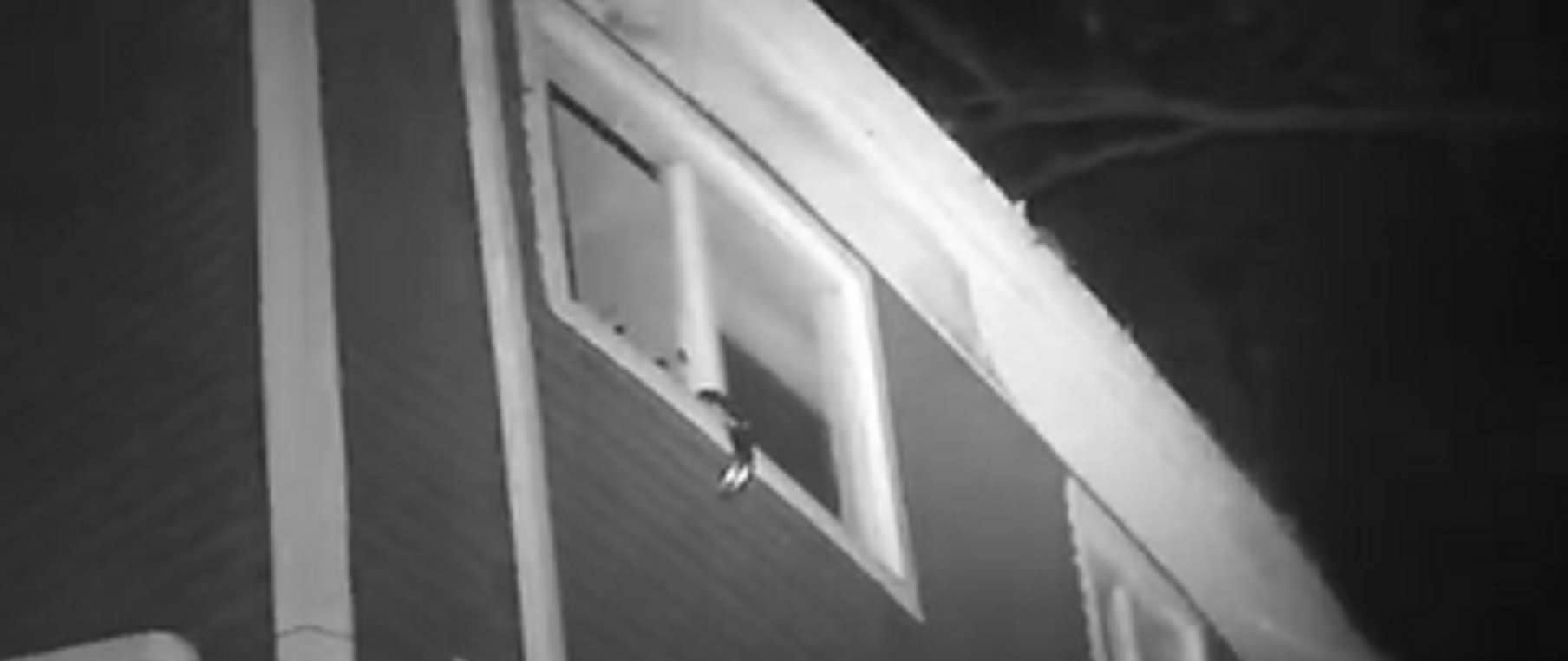
The homeowner suspects that the officer’s job was to make small talk and keep him occupied. This suspicion arises from the officer asking if the homeowner had guns, without asking for permission to search for them. Meanwhile, the units inside the house, who were supposed to be retrieving the DVR located on the second (middle) floor, were instead searching through the homeowner’s belongings on the third floor.
This situation suggests that the officer’s questioning about guns was a distraction tactic, intended to keep the homeowner preoccupied while other officers conducted an unauthorized search. The fact that the officers were rummaging through items on the third floor, far from where they were supposed to be, further indicates potential misconduct and a lack of respect for proper search protocols.
The next day, the Fire Marshal took pictures, and in these images, the ladder was removed, and the window was shut. He also took a picture of the child’s room. Clear as day, you can see the ladder and the box. Interestingly, none of the interior pictures were included in the discovery file against the defendant.
This omission is significant as it indicates a lack of transparency and potentially deliberate withholding of evidence that could be favorable to the defense.
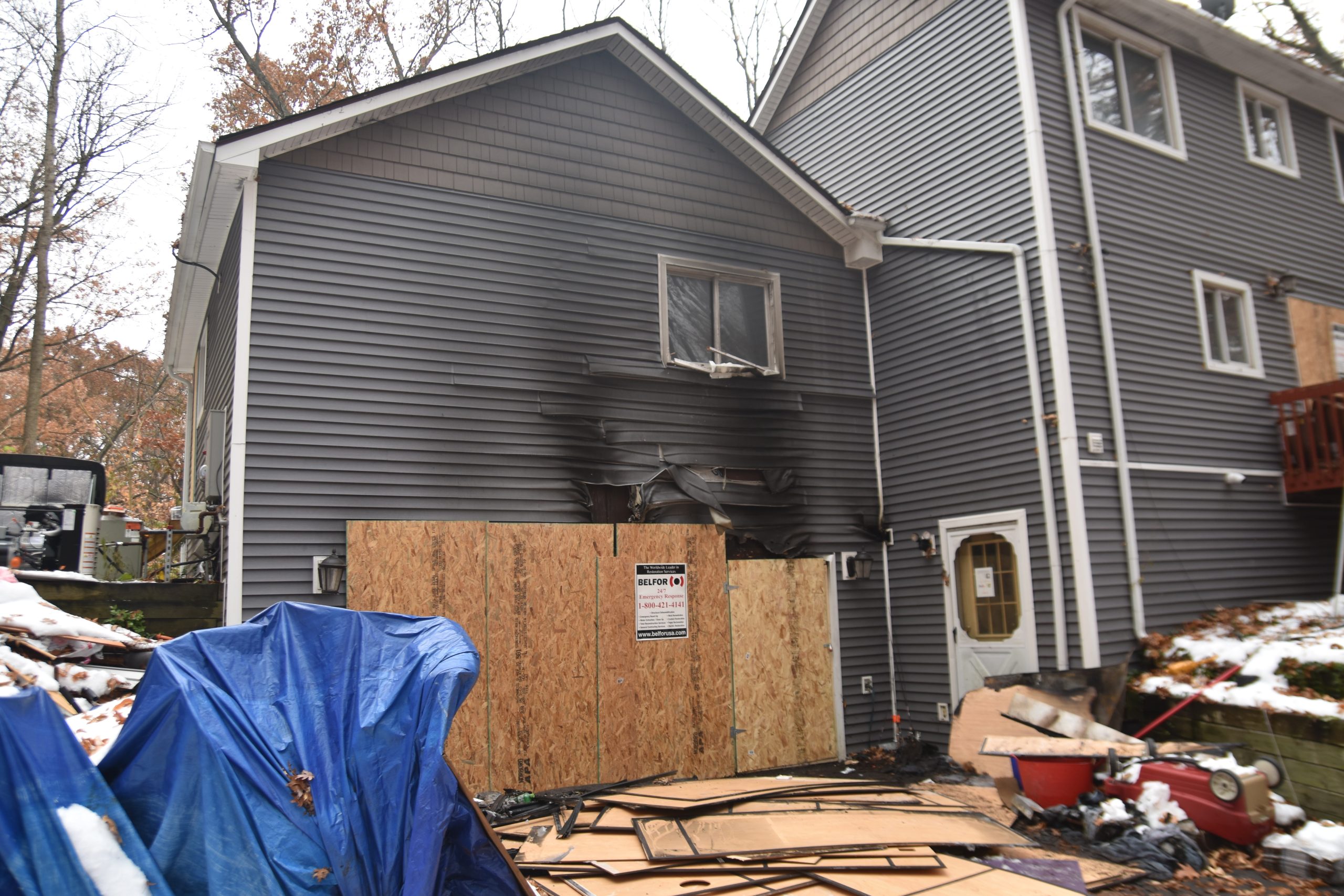

The homeowner was able to locate a picture from 2018 that clearly shows the location of the ladder in his closet, not in his son’s room. This photo serves as crucial evidence, corroborating the homeowner’s claim that the ladder was originally stored in his own bedroom closet and was never placed in his son’s room
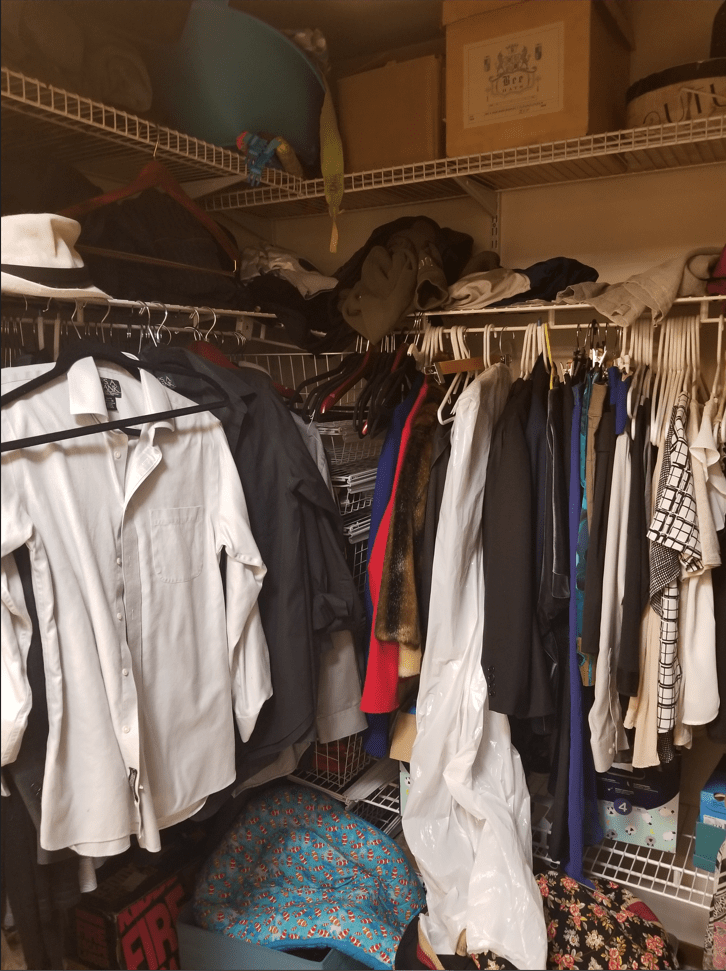
We are confident that Hamburg initially installed the ladder, but the challenge lies in proving its removal as well. When Belfor arrived on the night of the fire to secure the premises, they took photographs before working. Interestingly, these photos show the window closed and the ladder missing. This indicates that someone had removed it. The only individuals with access to the house at that time were Jordan Zernick and Officer Flavin.
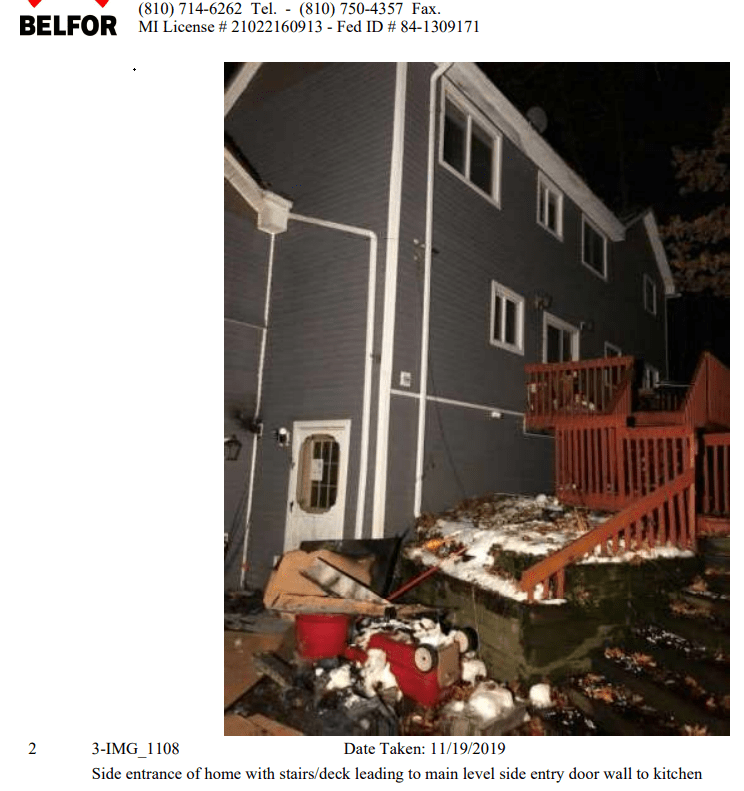
The homeowner was now certain of foul play within his house. However, he wanted to get the Fire Marshal on record, so as part of the preliminary examination, Operation 232 was initiated to solicit the truth. During the examination, the Fire Marshal doubled down, acting as if he did not know anything about the ladder, despite discussions and footage recorded on body camera showing otherwise.
To ensure this wasn’t an oversight, the defense also asked if anyone was trapped upstairs during the fire. This question was crucial because if no one was trapped, there would be no legitimate reason for firefighters to use the ladder for an escape, thereby negating any claim that its deployment was part of emergency operations.
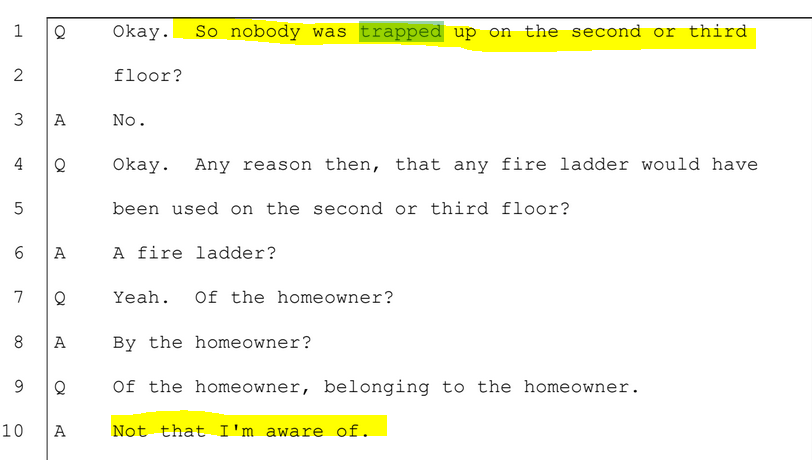
The Fire Marshal, steadfast in his ways, once again engaged in questionable behavior, and it wasn’t his last instance. One of his final acts before the homeowner’s arrest was modifying his report and omitting originally documented information. This alteration would prove significant to the actions taken on the night of the fire. In one report narrative, the Fire Marshal admits to “walking through the building” with Officer Flavin, while in another narrative, this detail is omitted and changed to “walking around”. The homeowner was able to retrieve the submitted incomplete report and compare it to the report submitted to the prosecutor’s office.
The changes between the two narratives address the scope of the investigation (external vs. internal) and the interactions with the homeowner. The shift from “walk around” to “walk through” is significant, as it touches upon legal aspects of property entry and consent. The Fire Marshal did not have consent, as homeowner had not “returned to the home” that evening yet. Testimony showed that the only interaction the Fire Marshal had during the day with the homeowner was brief, suggesting he stay on the premises. The original phrasing might have been an attempt to sidestep potential legal issues, while the revised version providing a different account but could raise questions regarding the legality of the entry and investigation. Which we have already established that there was no signed consent or verbal consent before the home owner arrived the evening of the fire as well as by admission under testimony by the fire marshal. When homeowner did arrive the scope was limited to the laundry room for a DVR and to retrieve his desktop computer.
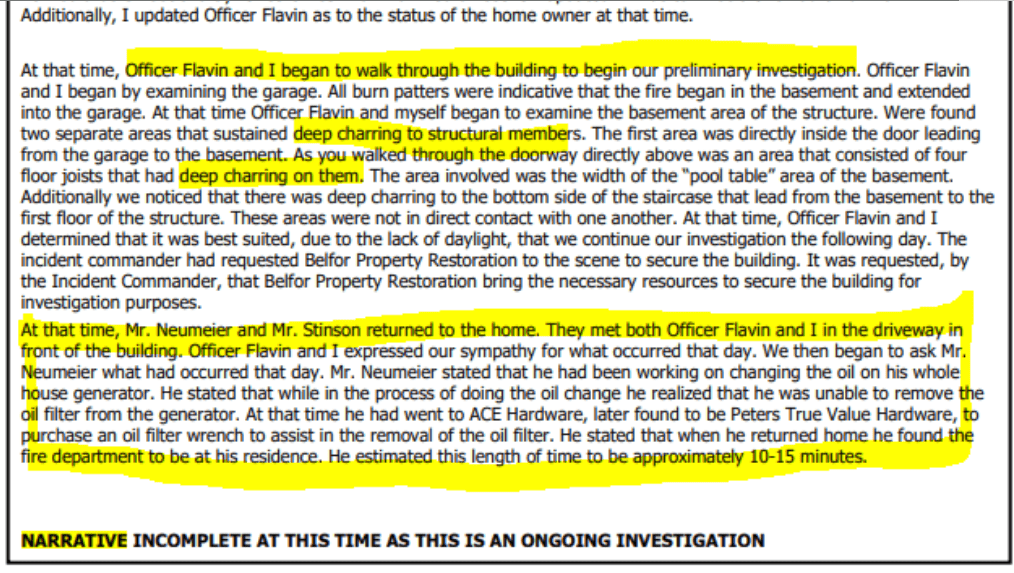
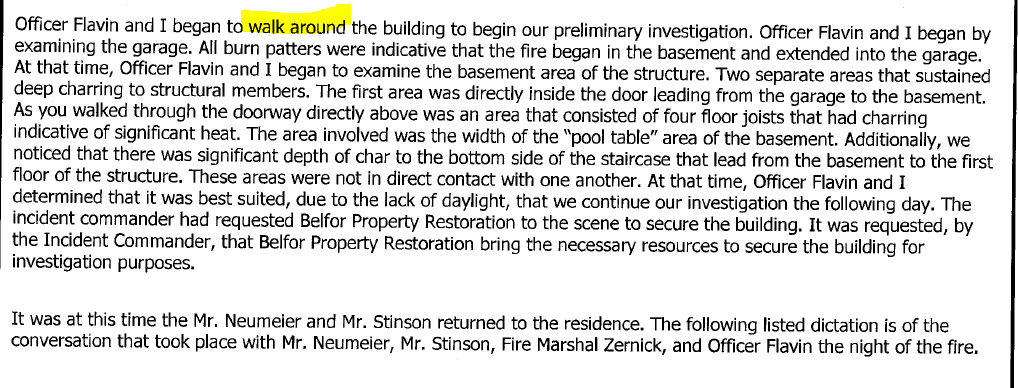
When something doesn’t work, the age-old question “Have you checked to see if it’s plugged in?” comes to mind, emphasizing the importance of starting with the basics. Following this principle, the homeowner went back to the Hamburg Fire Department and focused on the fire investigation team. Through testimony and reports, he identified the team members: Fire Marshal Jordan Zernick, Sergeant Harpe, and Officer Flavin. This group collectively handled fire investigations in Hamburg. However, there was a significant issues about them being certified fire investigators by NFPA 1033 standards along with following NFPA 921 to investigate the fire, a fact conveniently omitted from their reports that most all fire investigators reference in reports.
If you were to ask the chief of police who the certified fire investigator is, you might receive a response like, “I would refer you to Deputy Fire Chief Jordan Zernick, who heads up our fire investigative unit, as he would be able to better answer your questions.”
This statement implies a level of expertise that the team did not possess. The homeowner had to dig deeper to uncover that, while the Hamburg Fire Investigation Team may have had permission to investigate according to policy, they lacked or ignored the qualifications set by NFPA 1033 or any other reasonable standard required to determine the cause and origin of fires.
In an honest moment, Sergeant Harpe admitted under oath that he was not an expert and had never determined the cause of a fire. This admission highlighted a glaring deficiency in the qualifications and capabilities of the team responsible for investigating serious incidents like this one. He would also later admit to not being NFPA certified.
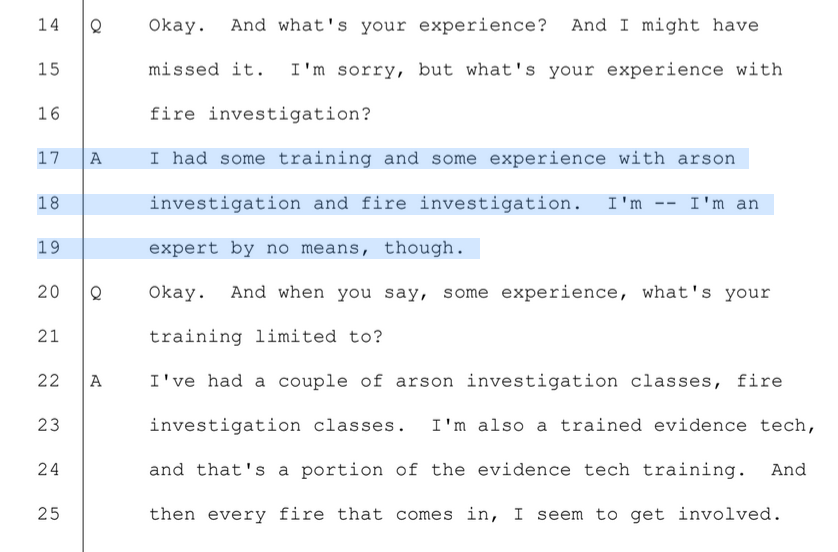

The homeowner sought verifiable evidence and, through deep searches and FOIA requests from nearly every agency in Michigan, obtained the training and education records of the “fire investigation team.” What he discovered was both unsurprising and a source of significant frustration. The leading training provider for law enforcement in fire investigations is the Michigan State Police, which offers a Level 1 ten-day fire investigation training program, as well as Level 2 training. Before attending these programs, participants must complete the CFI Trainer, an online training system specializing in NFPA 1033 and NFPA 921 education. The homeowner was familiar with these requirements, having completed CFI and NFPA courses himself, and they are clearly outlined on the michigan.gov website.
The training records revealed that on August 4, 2018, Officer Harpe attended a single 9-hour class on Fire Scene Preservation and Investigation—far short of the comprehensive ten-day training required for Level 1 certification plus the required CFI. While Sergeant Harpe holds qualifications in various police-related fields, including taser training, he lacks expertise in fire investigation. This lack of qualifications was confirmed when Harpe admitted under oath that he was by no means an expert. In another related hearing Sergeant Harpe also testified to not being NFPA certified.
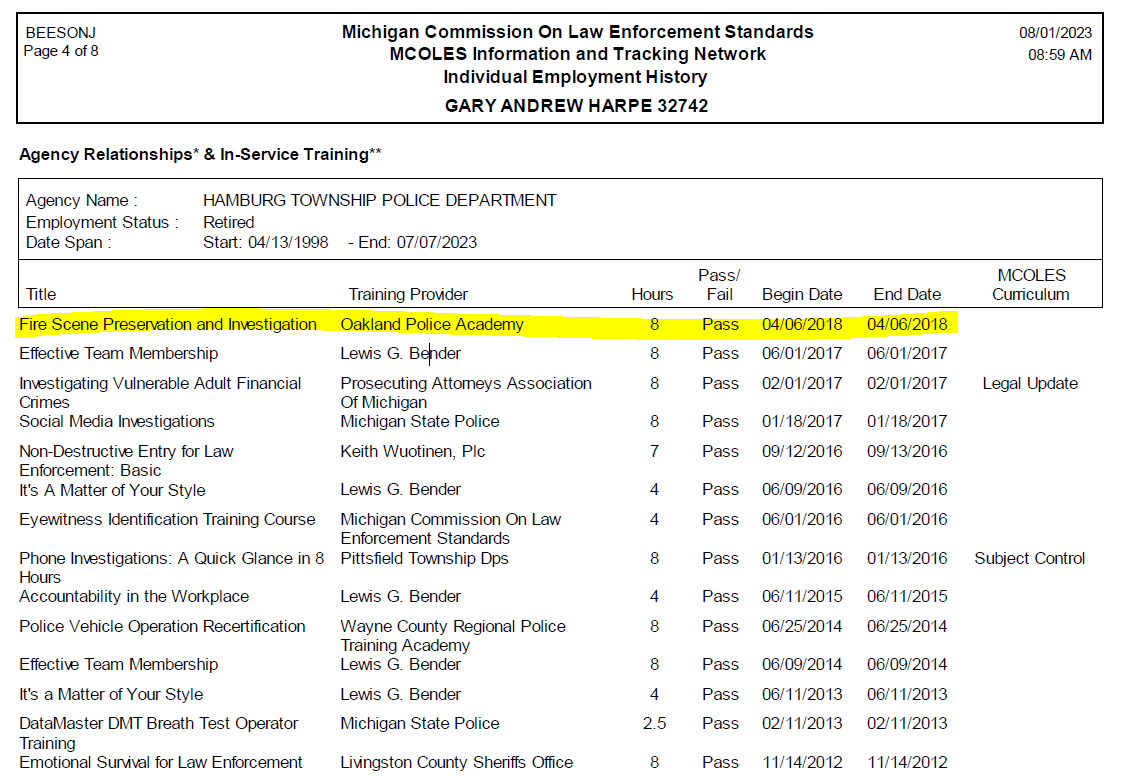
As for Officer Flavin, he completed a 16-hour Fire Investigation class on May 3, 2019, and attended the Fire Investigation Level 1 course on October 17, 2016. He would also attend Live Burn School in 2017. Although this training was more substantial than Sergeant Harpe’s, it was still limited. Notably, it should have been enough for Officer Flavin to know the importance of obtaining a consent form on the night of the fire and when to get a search warrant. His testimony under oath revealed that his role in fire investigations primarily involved “sometimes assisting the Fire Marshal,” collecting evidence, and interviewing people. He did not have a substantial role in determining the cause and origin of fires, nor did he possess the qualifications to do so in this case.

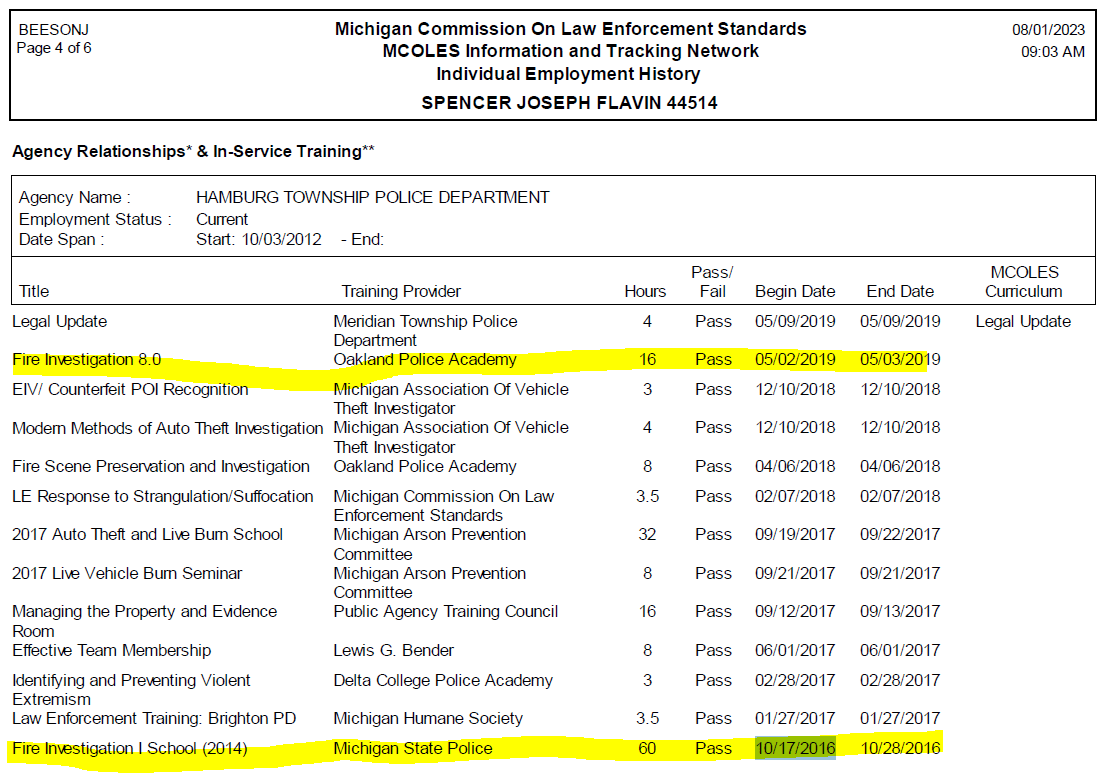
Fire Marshal Zernick was assumed to be the individual with the most extensive fire investigation training. However, his credentials through MSP are notably limited according to the Michigan State police. While we were able to locate his application for Fire Investigation 1, no further data was provided, and the Michigan State Police records suggest that he has no additional training records with them.


It is believed that the Fire Marshal’s limited training would have included at least some NFPA 1033 qualifications, raising concerns about his competency and the thoroughness of the investigation. To better understand the situation, the homeowner decided to dig deeper, seeking additional information about the Fire Marshal’s credentials and training background.
The homeowner wanted to verify whether any other agencies had records of the Fire Marshal’s training, so he checked with LARA (Licensing and Regulatory Affairs) and the Bureau of Fire Services, a branch of LARA. As expected, no additional training records could be found. This lack of documentation further reinforced concerns about the Fire Marshal’s qualifications and the overall integrity of the investigation.
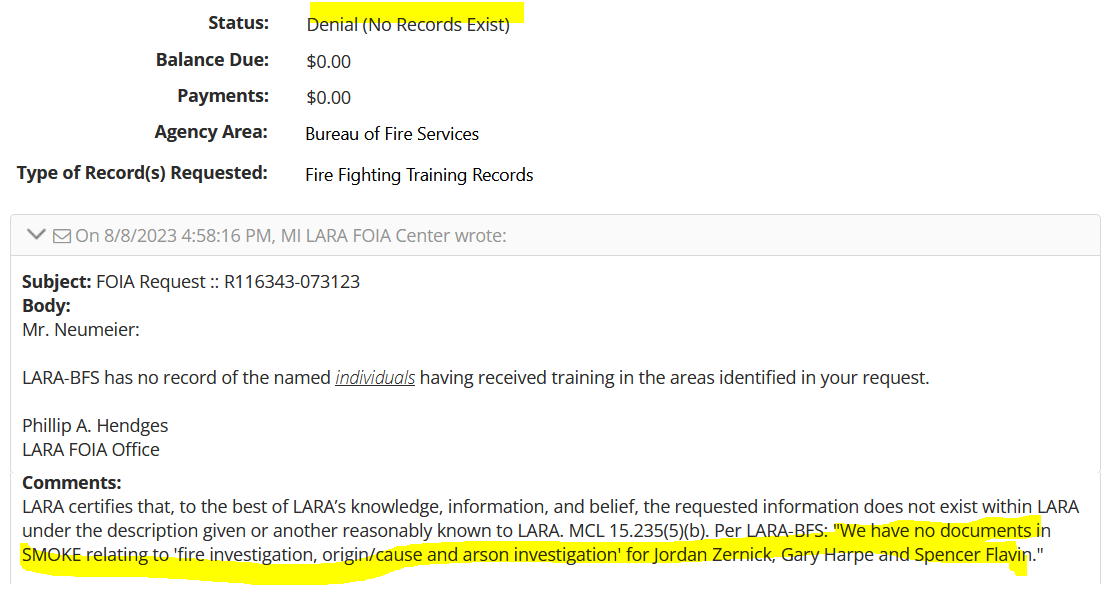
This information highlights the significant gap in the expertise of the Hamburg Fire Investigation Team, underscoring the potential mishandling and misinterpretation of the fire investigation.
LARA, Michigan’s Licensing and Regulatory Affairs department, confirmed through its Bureau of Fire Services Fire Fighter Training Division’s System Maintenance of Knowledge and Education (SMOKE) system that there are no training records for any members of the Hamburg fire investigation team related to fire investigation. This further underscores the lack of formal qualifications and training within the team responsible for handling the investigation.
The best course of action would have been for someone on the Hamburg fire investigation team to follow the FIRE PREVENTION CODE, Act 207 of 1941, and then simply call the Michigan State Police, who have certified fire investigators available 24/7 on call. Had this been done, the investigation could have been conducted with certified professionals, potentially leading to a more honest and fair and unbiased outcome, in the homeowner’s opinion. The failure to adhere to established rules and protocols significantly contributed to the mishandling of this case.
Having established the lack of training and education among the Hamburg Fire Investigation Team, the question arises: how did this case proceed to trial, and how were members of this team allowed to testify against the homeowner?
According to Liam Carroll, the Certification Chief of the Fire Fighting Training Division within the Bureau of Fire Services, explained to the homeowner that even after receiving their initial NFPA 1033 certification, individuals must meet further requirements to be qualified to testify as expert witnesses in court. These requirements include investigating numerous fires under the supervision of a vetted expert fire investigator. Additionally, they must complete further online training courses and attend International Association of Arson Investigators (IAAI) conferences to build a comprehensive resume and demonstrate proficiency in fire investigation. Only with these qualifications can an individual be deemed qualified to testify in court as an expert witness.

This would effectively remove and disqualify every member of the Hamburg Fire investigation team from testifying as an Expert Fire Investigator. Despite the shortcomings in the qualifications of the investigation team, the case moved forward in the judicial system. We can get into law later on but for now let’s dismantle the case.
When comparing the initial written reports to the testimonies given in 2022 and then in 2024, there is a stark difference. Anyone examining the discrepancies could only conclude that deception was a key component of the witnesses’ accounts.
The Hamburg Fire Investigation team testified and documented that their investigation was separate from that of Jeremy Berard, the investigator hired by the homeowner’s insurance company. They claimed they were not working together. This approach aligns with best practices, as collaboration between government agencies and other investigators can lead to extreme bias.
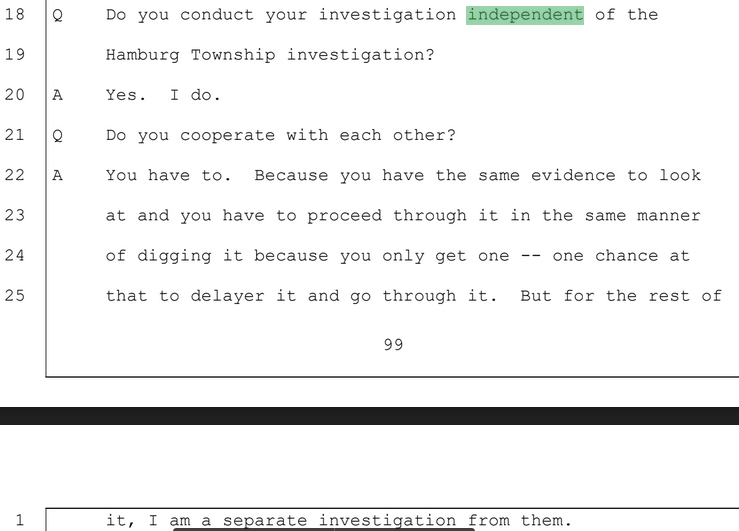


According to NFPA 921 (Guide for Fire and Explosion Investigations) and NFPA 1033 (Standard for Professional Qualifications for Fire Investigator), it is critical to maintain the integrity and impartiality of an investigation. NFPA 921 emphasizes the need for a systematic approach to fire investigations to avoid bias, while NFPA 1033 outlines the professional qualifications required of fire investigators, ensuring their objectivity and competency. Ideally, by conducting independent investigations, the Hamburg Fire Investigation team would have adhered to these standards, ensuring a fair and unbiased process. However, they did not.
During the interrogation, the Fire Marshal acknowledged working with Jeremy, the insurance investigator, which already raised concerns. But this collaboration pales in comparison to what Jordan Zernick, the Fire Marshal, actually allowed. In the middle of the investigation, Hamburg Public Safety relayed to the insurance investigator that a crime had occurred and that the homeowner was a suspect. This information was then reported to the insurance company by Jeremy Berard, the insurance investigator. This breach of impartiality not only violated NFPA guidelines but also compromised the investigation’s integrity by introducing bias and undermining the objectivity that is critical in determining the true cause of the fire.
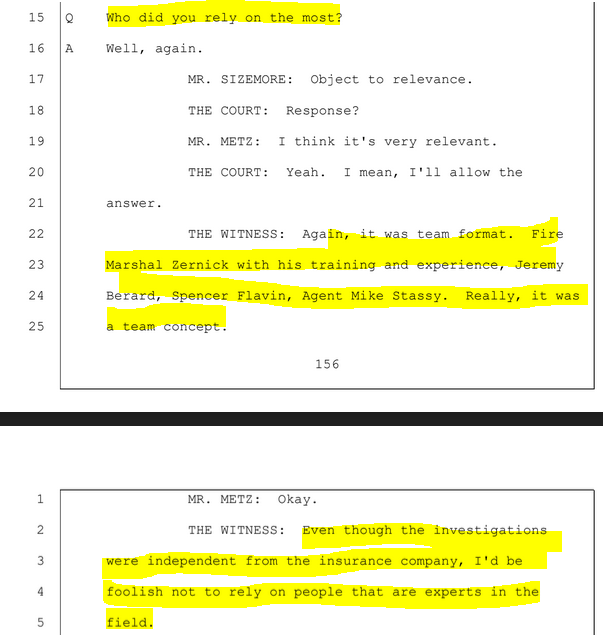

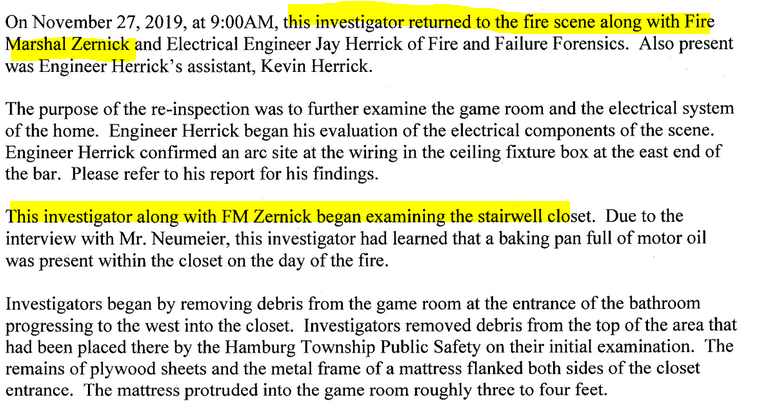


Two of the most concerning aspects of this situation are that the fire department and the insurance investigator, who should have been working independently, did not maintain their independence, thereby completely biasing any fair investigation. This is evidenced by two key pieces of evidence:
-
In the insurance investigator’s report, he claimed that he informed Fire Marshal Jordan that the lamp and related items were an incendiary device. This communication should not have occurred, as it could influence the fire marshal’s findings, compromising the objectivity required in an independent investigation.
-
Additionally, there is a log showing that the fire department informed the insurance investigator during the mid-investigation that a crime had occurred and that the homeowner was a suspect. This premature sharing of critical information could have led the insurance investigator to approach the investigation with a bias against the homeowner, further undermining the integrity of both investigations.
These actions suggest a collaboration that compromised the impartiality and fairness of the investigation, leading to potentially biased conclusions that could have serious implications for the homeowner.

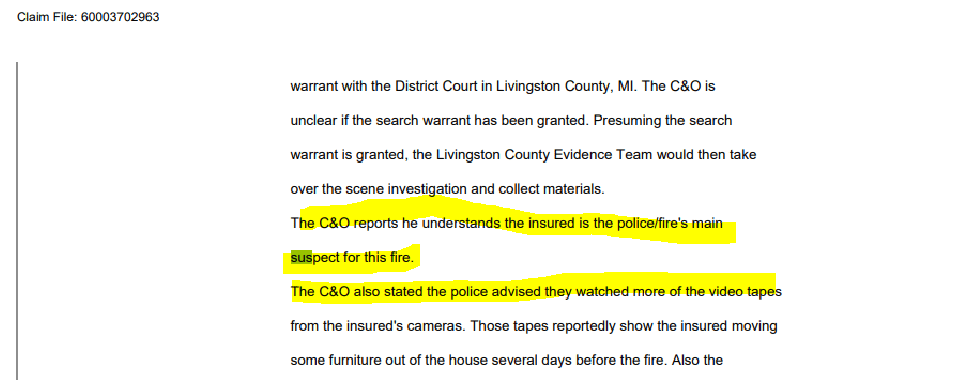
When it comes to testimony, reports and statements there were significant discrepancies between what was said and what was reported or stated in other places, causing major conflicts in determining the truth. Hamburg Public Safety officers continued this pattern for years and ultimately doubled down in court, despite knowing they were not being honest. These inconsistencies and the persistence in presenting false narratives severely undermine the credibility of the investigation and the integrity of the legal process, making it difficult to uncover the actual events surrounding the fire. The homeowner would go through testimony word by word, story by story, assumption by assumption and fact by fact to uncover the truth.
In an effort to clear his name, on February 2, 2023—over three years after being accused—the homeowner agreed to take a polygraph test administered by the police. Upon arriving at the polygraph exam center with his attorney, the homeowner was informed by the officer that his attorney could not stay and had to leave. The homeowner then spent nearly four hours with the officer, answering questions.
During the interview, the homeowner noticed something unusual: a phone jack facing his chair, positioned slightly higher on the wall than typical phone jacks. Given his background in technology and management at Radio Shack, the homeowner recognized that this jack was suspiciously different—it was blacked out, lacked prongs, and seemed out of place. When the officer temporarily left the room, the homeowner investigated further and discovered that the jack was actually a hidden recording device.
When the officer returned, the homeowner did not mention his discovery but instead asked if he was being recorded. The officer denied it, citing HIPAA laws as the reason, stating that recording would be a violation since they were discussing health issues. However, through his efforts in Operation 232, the homeowner later uncovered that this was a lie.
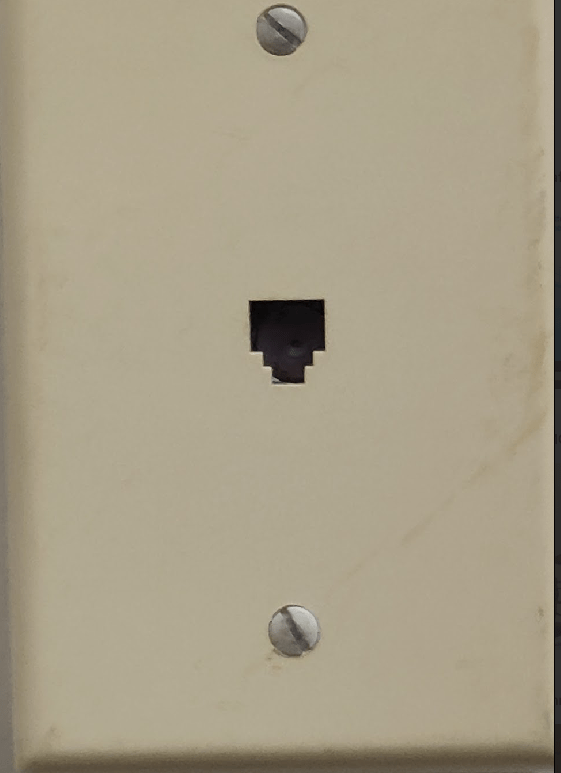
Four hours into the polygraph exam, after it had concluded, the homeowner was preparing to leave when his attorney reappeared and asked the police officer how the test went. To the homeowner’s surprise, the officer claimed that the homeowner did not cooperate. This statement shocked the homeowner, as he had answered every question, remained polite, and was there to clear his name. Sensing that something was off with the polygraph test and suspecting that something else was going on, the homeowner chose not to argue and instead decided to wait for the written results. He would receive the report from his attorney within 48 hours of completion the polygraph.
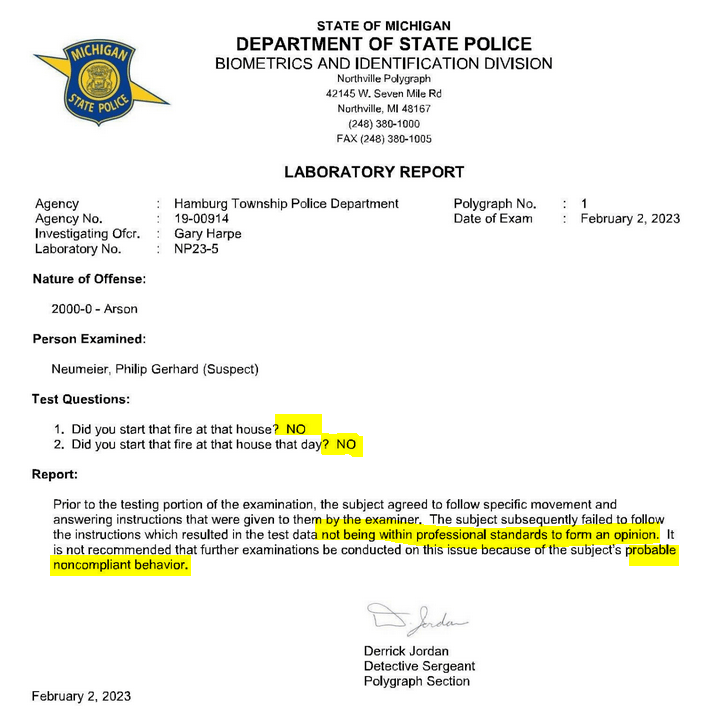
Upon reading the report, the homeowner was confused by the term “probable noncompliant behavior” and questioned why it was phrased that way, as one is either compliant or not. He suspected this was more a matter of wordplay and manipulation in the reports, and he decided to investigate further to understand why his behavior would be described as noncompliant. Knowing there was a hidden camera in the room, the homeowner began to believe that the entire situation was an attempt to solicit a confession to an alleged crime, rather than a genuine polygraph test.
Though the homeowner never admitted to any involvement in the fire, the suspicious nature of the polygraph report led him to seek more information and investigate the hidden camera’s purpose. This inquiry eventually uncovered a shocking truth about the biased and deceptive practices within the Hamburg Police Department.
During this process, the homeowner was also accused of impersonating a police officer. Fortunately, he recorded the call where this accusation stemmed from, and in doing so, got the officer to admit that there was indeed a recording, that Hamburg was behind the polygraph test, and that it was being streamed live through CCTV. This revelation further exposed the clear bias of the officer involved.
The homeowner began the phone call by clearly identifying himself, yet the officer seemed oblivious for several minutes, offering up details and even releasing medical information over the phone while simultaneously insulting the homeowner. Despite the homeowner’s transparency, the officer’s conduct reflected a troubling lack of professionalism and further confirmed the deceptive nature of the investigation.

**Quick Time Reference:**
1:26 – Homeowner states his full name.
3:20 – Acknowledgment of video footage.
3:35 – Homeowner requests the video.
3:49 – Officer states that for HIPAA reasons, the video is not recorded but confirms that other people were watching.
5:50 – Officer mentions manipulation of the polygraph (without yet knowing who the test was for).
7:00 – Homeowner requests the video again; the officer states it was a live broadcast in a viewing room.
7:25 – Officer finally asks who the test subject is. The homeowner responds with his full name.
7:47 – Officer calls the homeowner a “butthole,” then says the homeowner didn’t say anything that would need to be documented.
8:35 – Homeowner asks about being called a “butthole.” The officer says that’s nothing he would include in the report.
8:54 – Officer discusses the homeowner’s health and denies that the homeowner has neuropathy.
9:16 – Officer refers to other people watching the polygraph via CCTV and accuses the homeowner of moving his feet to manipulate the test.
10:13 – Homeowner requests the video.
11:15 – Video is confirmed.
After the frustration from this incredible phone call subsided, the homeowner realized that the polygraph test had been a staged event, designed to solicit a false confession, and that it had been streamed live to people watching. Now armed with proof of the intentions behind the polygraph, the homeowner sought to dig deeper. He arranged a meeting to recover the footage, determined to uncover more evidence of the deceptive practices at play. The homeowner directed the officer to his office to drop off the footage.

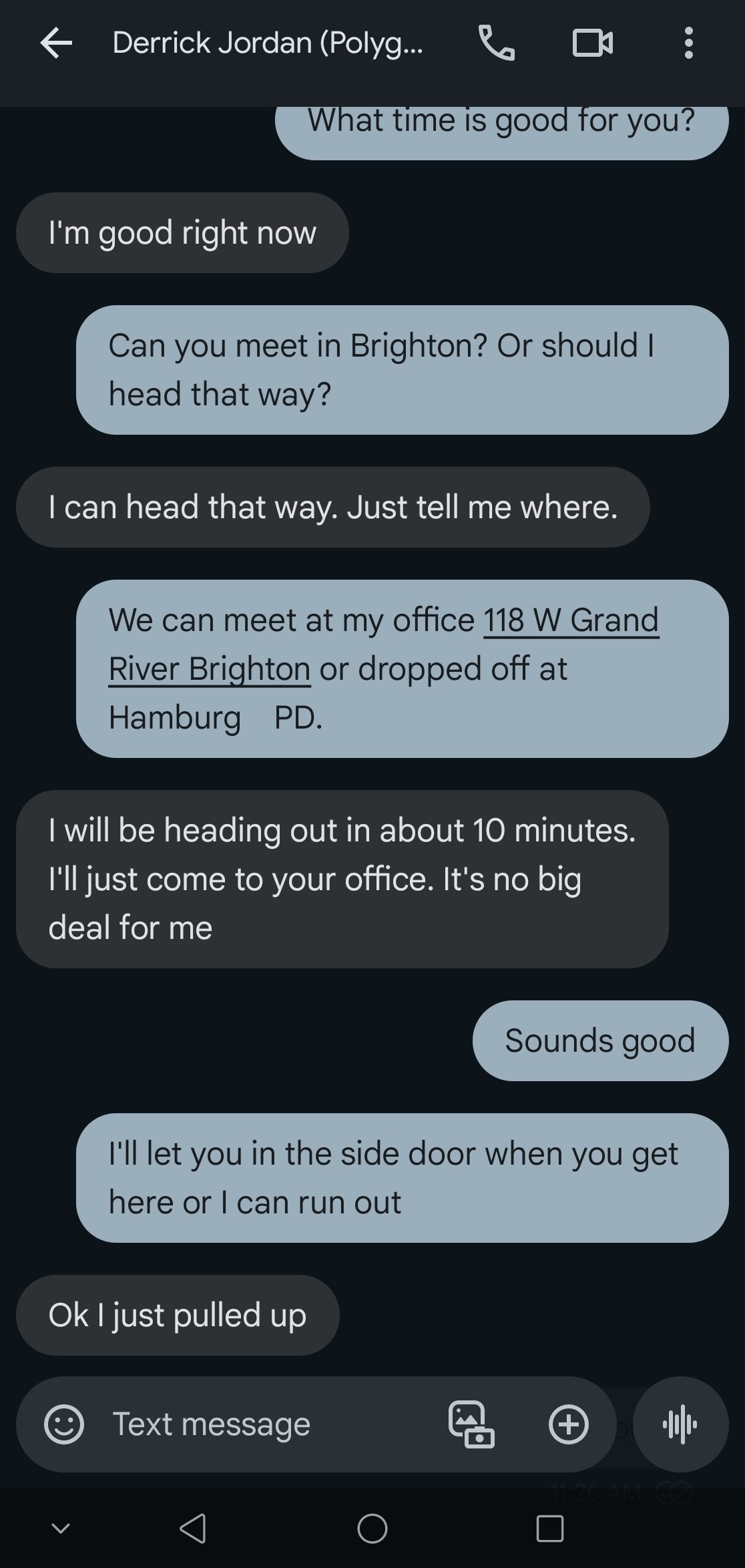
The homeowner was fairly certain that this encounter would not result in him obtaining the footage that day, but his intention wasn’t to retrieve it immediately. He knew that once it was established in person that the video existed, it couldn’t simply disappear. With this strategy in mind, he met with the officer, fully aware that confirming the footage’s existence would secure its preservation for future use.
The officer approached the side entrance as directed and was met by a staff member who greeted him and lead inside.
The officer was directed to have a seat at the conference table while the staff went to get the homeowner. Upon the homeowner entering the room, the officer immediately recognized him and stated that he couldn’t provide the recording. The officer states he thought the homeowner was an investigator for Hamburg Police, the homeowner say’s no and corrects the officer and states he is an investigator for CXVI group. The homeowner calmly directed the officer to drop off the footage to Hamburg police.
Aware of the falsehoods that had been spread about him and the suspicious nature of the CCTV streaming, especially after the officer had denied any recording while discussing his health, the homeowner knew he needed to record this encounter to prevent any misrepresentation. Fortunately, he did, as the next day, threats were made to charge the homeowner with impersonating an officer based on the original phone call. This recording served as critical evidence to protect the homeowner from further false accusations.
The officer proceeded to drive to Hamburg and dropped off the footage at the Hamburg Police Department. However, while there, a plan was set in motion to falsely accuse the homeowner of impersonating an officer. A member of the Hamburg Public Safety Department contacted the prosecuting attorney and requested that additional charges be brought against the homeowner for this alleged offense. This action highlighted the continued effort to undermine the homeowner and further complicate his legal situation.
The homeowner immediately sent his attorney the recorded phone call and provided documented medical history. Although no charges were ultimately filed, this incident demonstrated the lengths to which accusations would be fabricated to pursue the homeowner. Ironically, in 2019, the homeowner owned a neuropathy company that specialized in nerve pain relief for feet. Despite being told who was calling, the officer continued to act as if he was speaking to another officer and brought up the homeowner’s medical record, which he had earlier claimed it would be a violation of HIPAA. This contradictory behavior not only undermined the officer’s credibility but also highlighted a potential violation of privacy laws.

In fire investigations, the integrity of evidence collection and scene preservation is critical, requiring strict adherence to legal standards for documenting the chain of custody. In this case, the chain of custody was severely flawed, with incomplete documentation, missing details, and instances of non-government individuals handling evidence. The discovery file provided against the homeowner was largely blank when it came to the evidence collection, with all items dated November 19th, 2019, and lacked any true chain of custody records. A list of items taken was the sum of what was provided. This raises significant concerns about the reliability and integrity of the evidence, as proper chain of custody is essential to prevent tampering, contamination, and to uphold the validity of the investigation, as emphasized by NFPA 921 and relevant legal standards.

On Tuesday, February 15, 2022, a preliminary examination was held in this matter, during which Officer Harpe, Officer Flavin, Fire Marshal Jordan Zernick, and a third-party investigator (to be discussed later) took the stand to testify under oath. The transcript from this hearing was obtained and compared against the reports. Once again, the true colors of Hamburg Public Safety were revealed. Discrepancies and inconsistencies were noted in their testimonies.
Then, on July 24, 2024, a hearing on motions to quash evidence took place. During this hearing, the witnesses once again provided inaccurate, misleading, or outright false testimony. This session will be the focus, as these discrepancies are critical to understanding the case’s developments and the actions of Hamburg Public Safety
Throughout this ordeal, the homeowner has experienced relentless harassment and insults, been financially scrutinized and burdened, and suffered a significant mental toll. The staging of the house, hidden audio recordings, search seizures, and perjury against him have compounded these challenges. The relentless accusations have deeply impacted his life, affecting his well-being and stability. Additionally, he has been accused of tax evasion, faced undue scrutiny from city inspectors, been verbally harassed by MSP, accused of impersonating an officer (twice), and had reports manipulated against the truth.
In the reports created or established by the Hamburg Investigation, none explicitly state that the homeowner, is an arsonist or a suspect. Despite this, he was charged with second-degree arson, which carries a potential sentence of up to 20 years in prison. Court documents indicate that the homeowner was cooperative and forthcoming throughout the investigation. However, the legal process has been prolonged, as he has faced three judges and three prosecuting attorneys without yet going to trial.
Philip Neumeier is a member of the ALOA and the NAFI (National Association of Fire Investigators). He holds a degree in business administration and is the founder of multiple companies. He has been a member of Livingston County for over 25 years. Previous to this event he has never been arrested. During “Operation 232,” he was threatened with charges of impersonating a member of the NAFI and accused of providing bogus license numbers. These accusations were false. His member ID is 25412
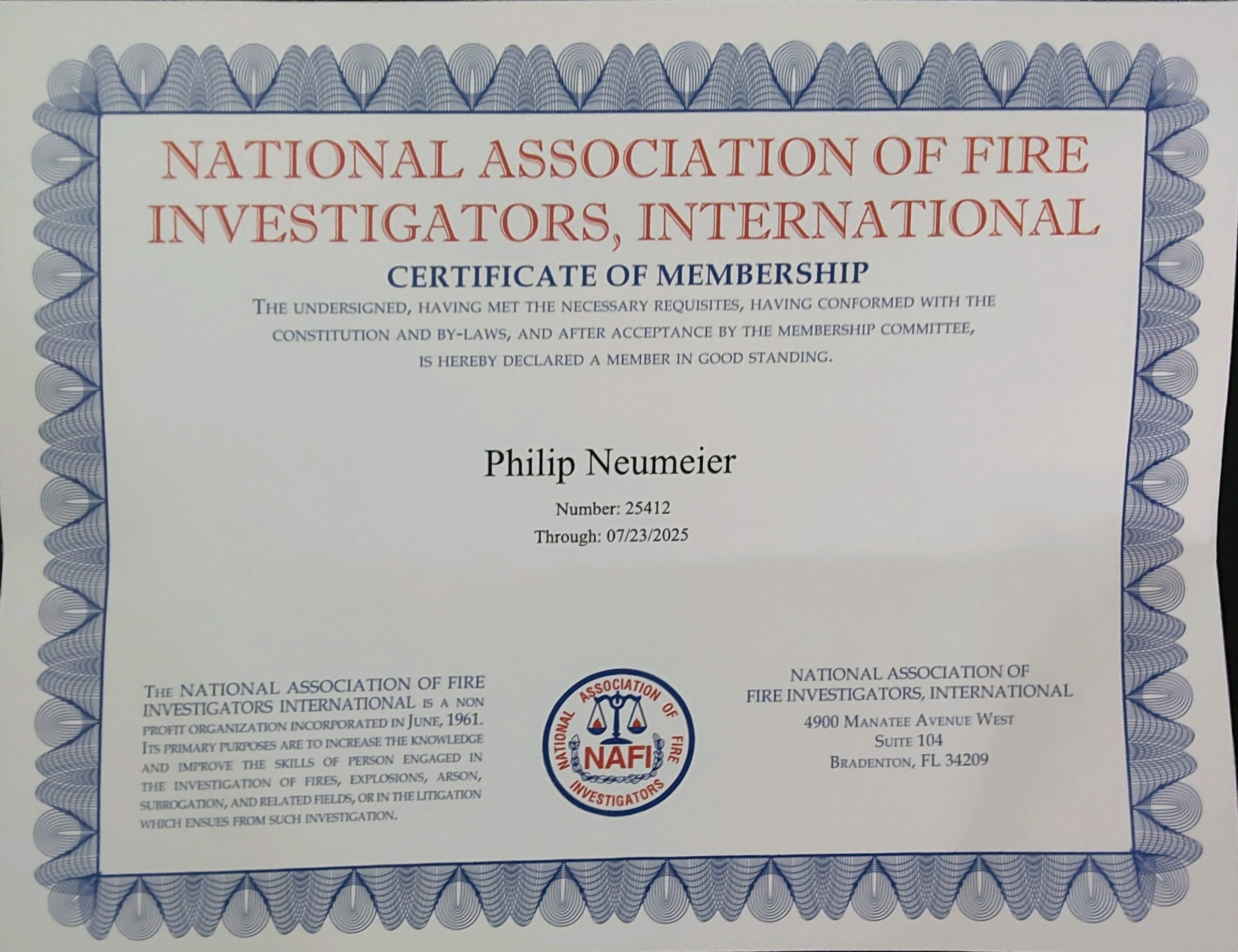
The evidence against the homeowner is circumstantial. A substantial amount of evidences and/or testimony was misused or fabricated. Operation 232 was intended to establish awareness for the common good of the people.
Disclaimer: This article includes snippets of testimony, evidence, and information, which are provided for informational purposes only and should not be interpreted as legal advice. Behindthefire.org, its associates, writers, or contributors do not make any claims or assertions regarding the content of this article. All individuals mentioned are presumed innocent until proven guilty in a court of law. Any references to criminal activity are allegations, and no one has been convicted at this time. We encourage you to review our evidence page to see everything in its entirety. Readers are strongly advised to use this information responsibly, conduct their own research, and consult with a qualified attorney for legal guidance specific to their situation.
Change Log:
10/3/2024 – Addition of Part 2 link
10/3/2024 – URL correction Beyondthefire -> Behindthefire
Behind The Fire - Hamburg, MI is proudly powered by WordPress
